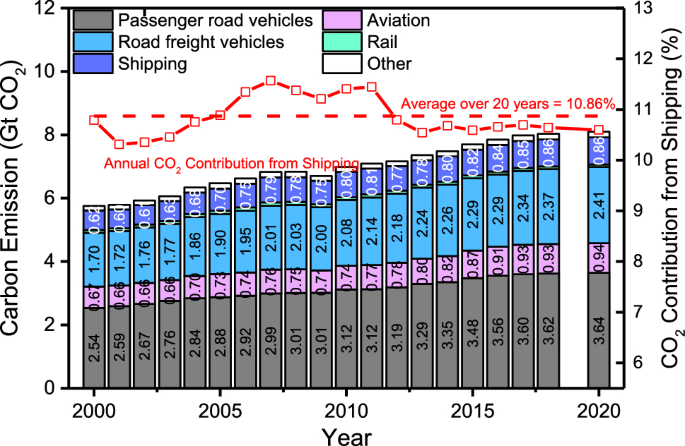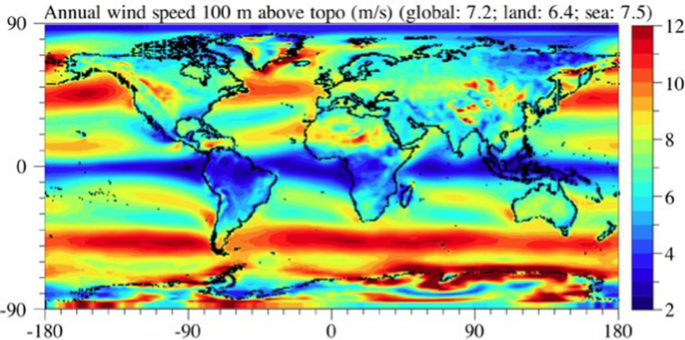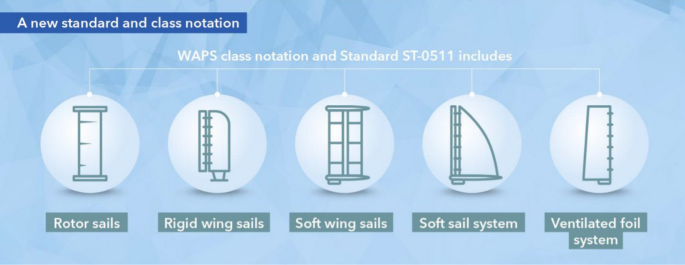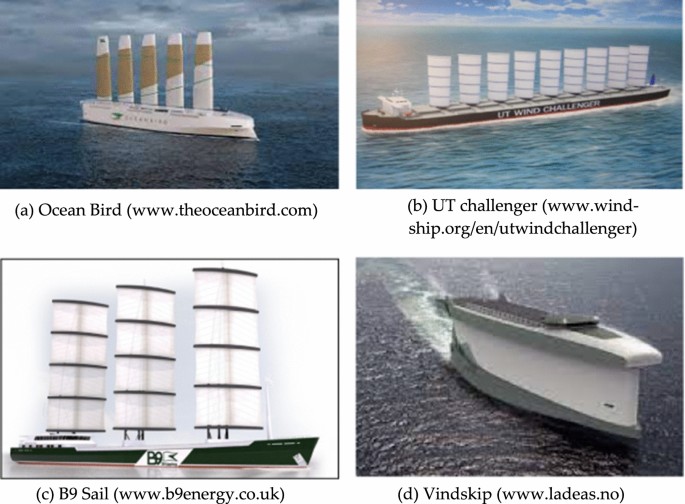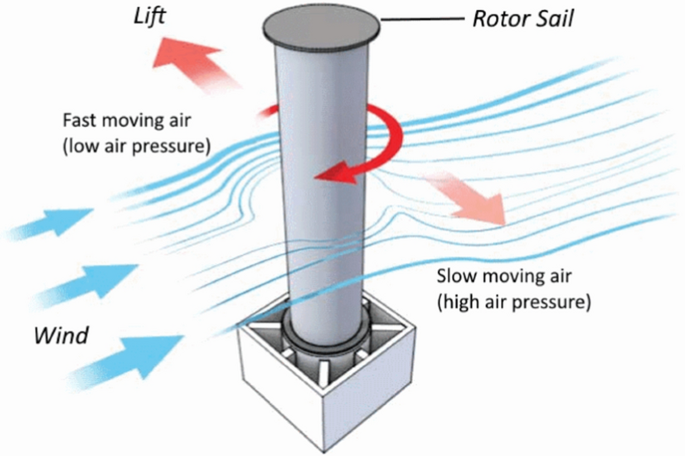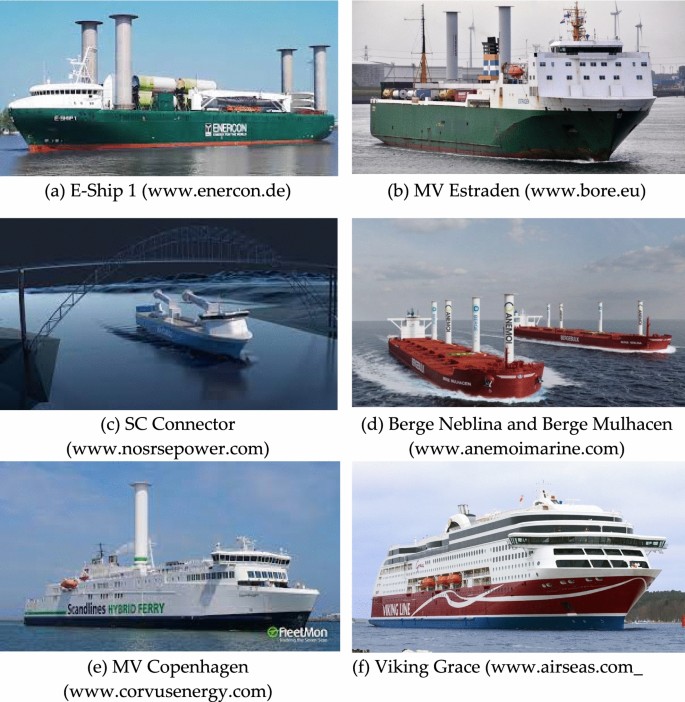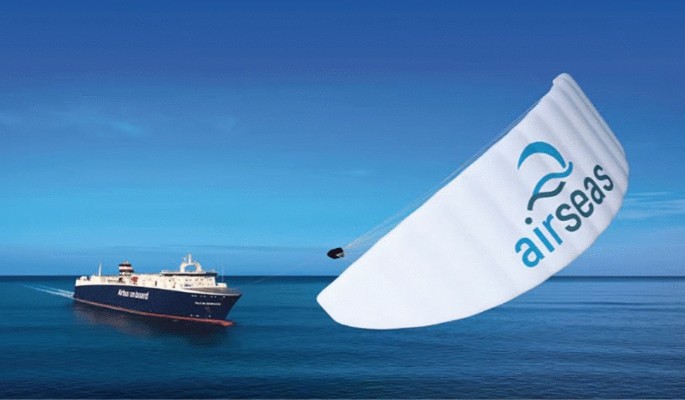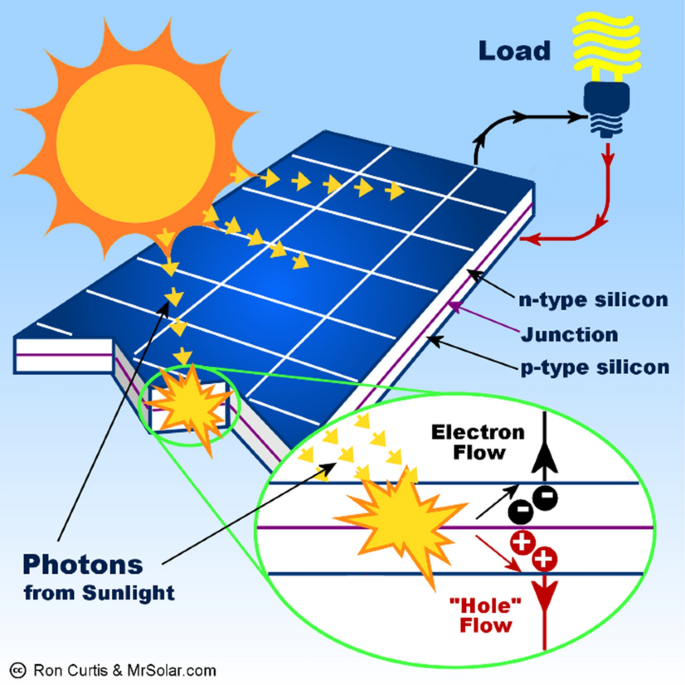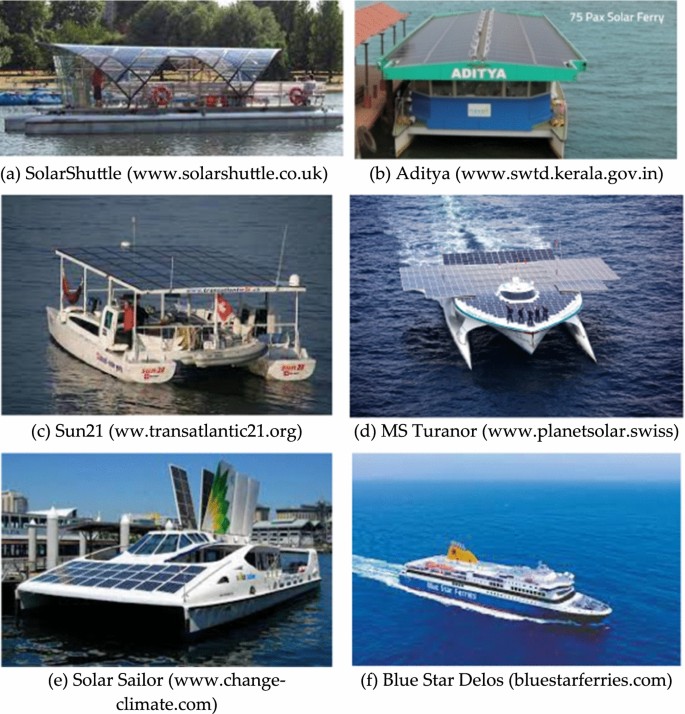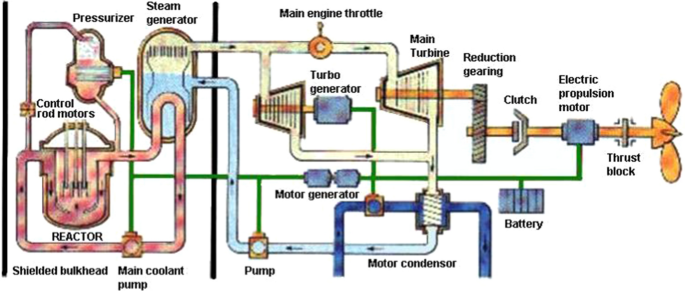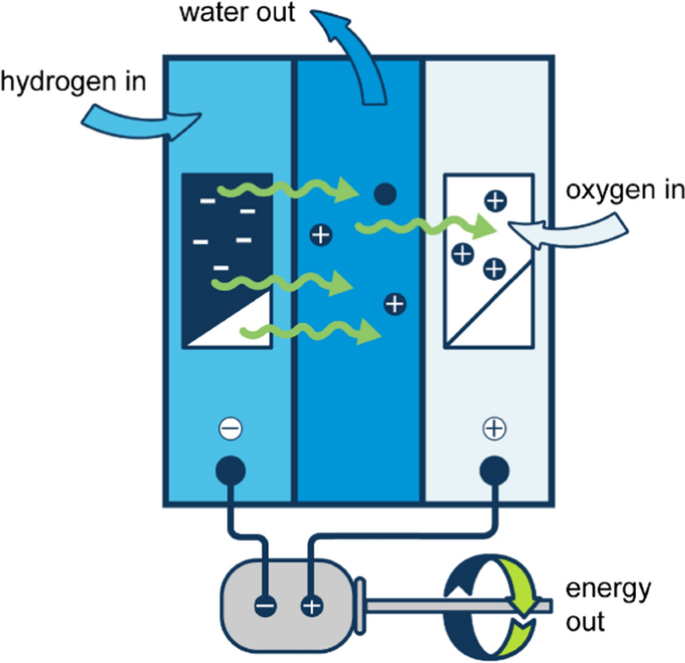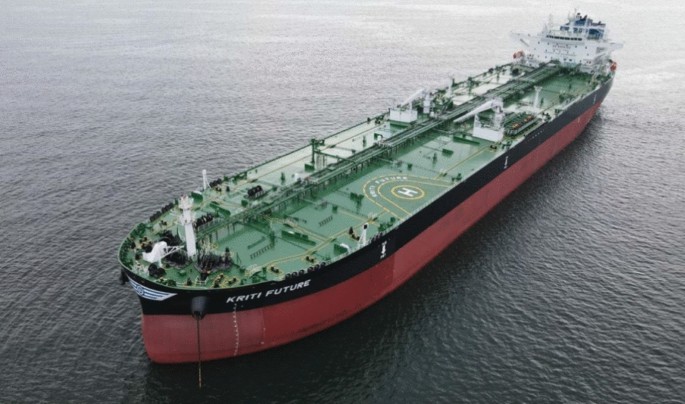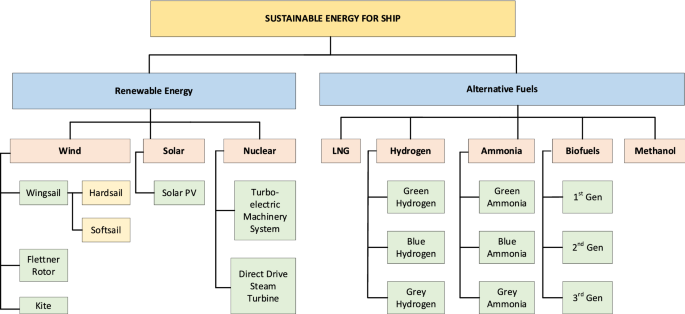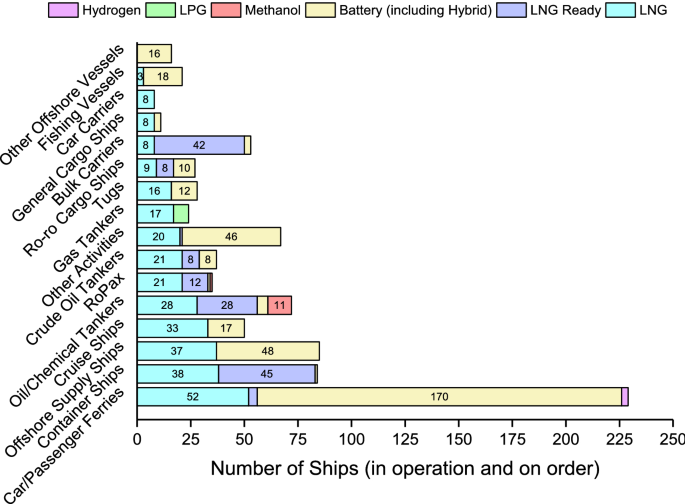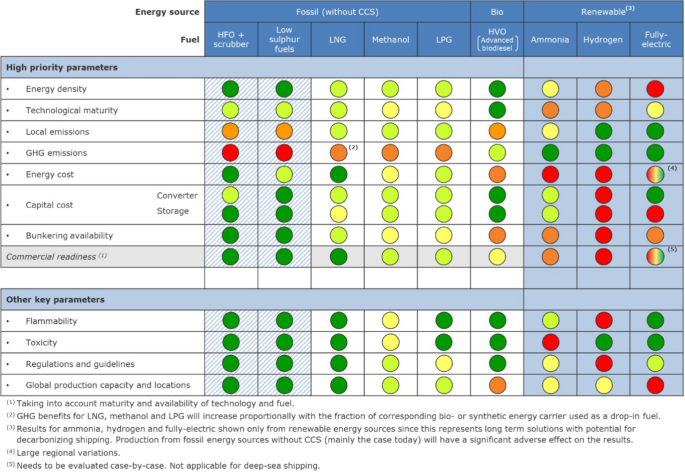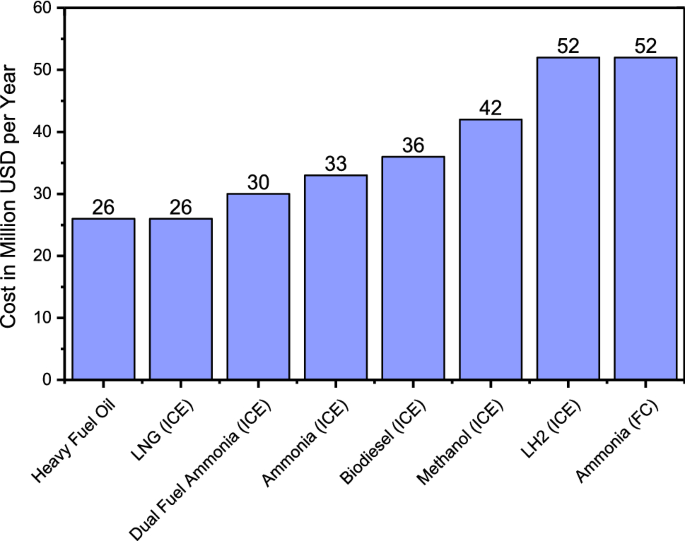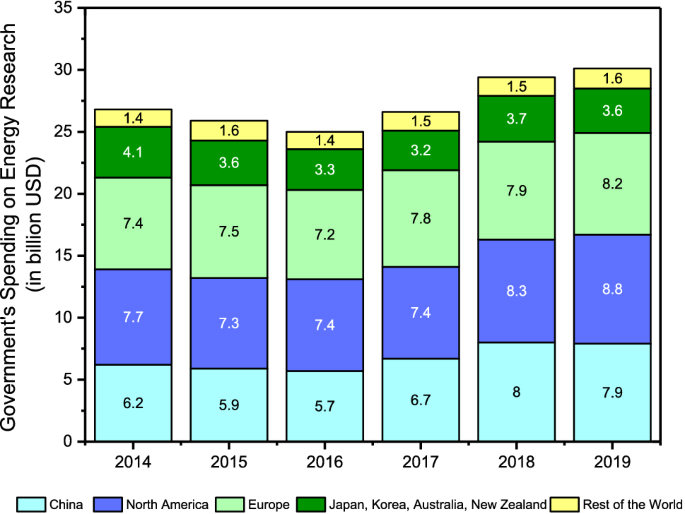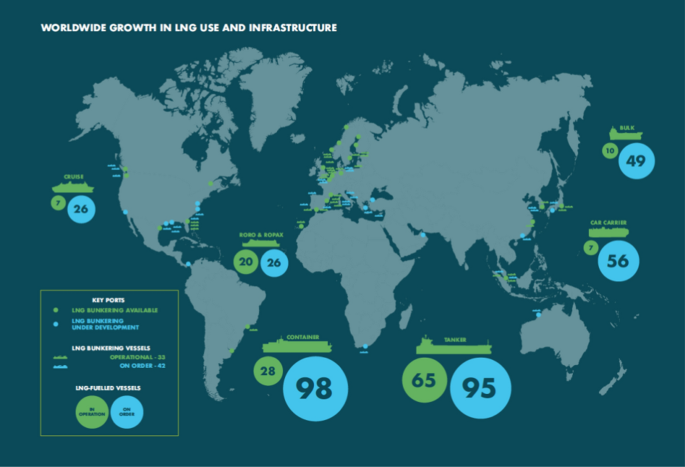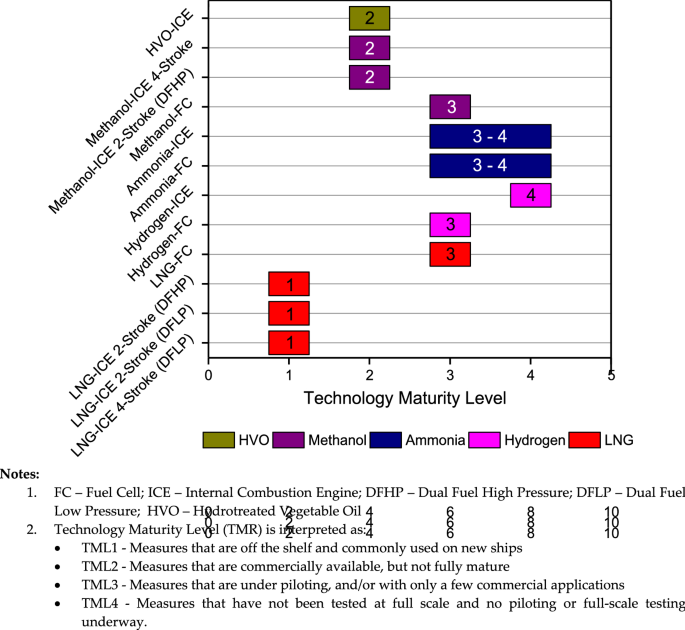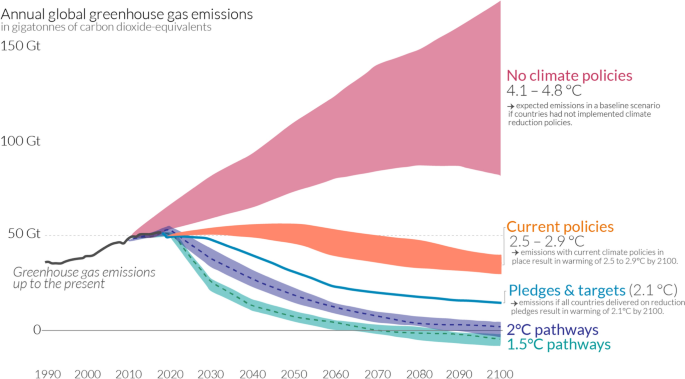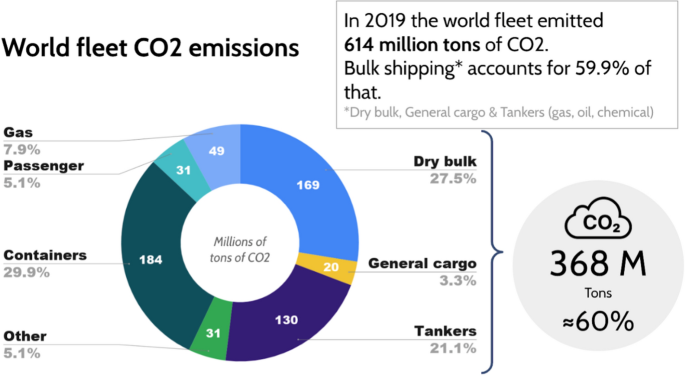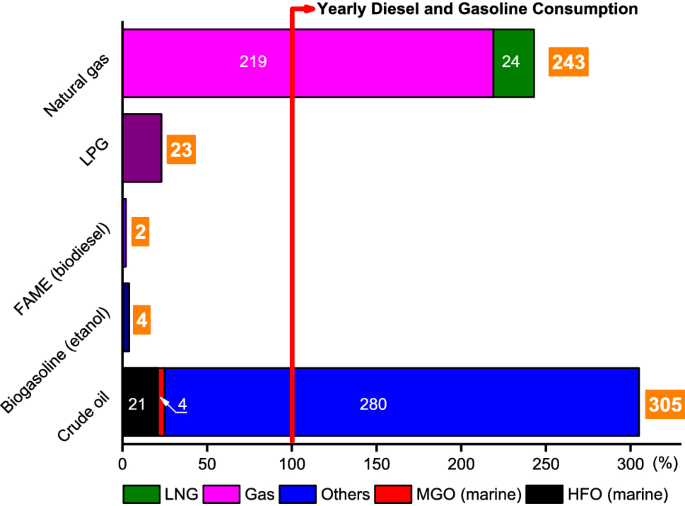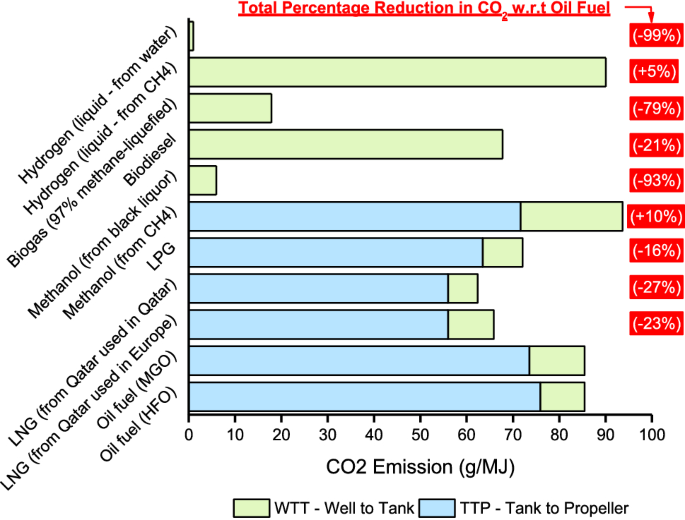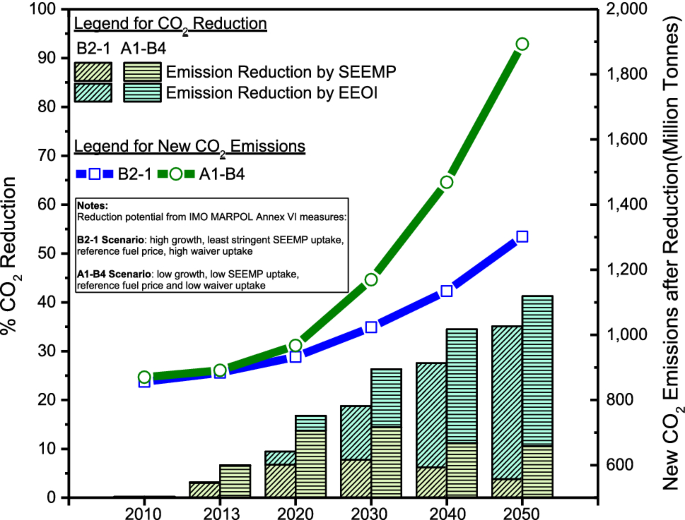Abstract
The cost of renewable energy technologies such as wind and solar is falling significantly over the decade and this can have a large influence on the efforts to reach sustainability. With the shipping industry contributing to a whopping 3.3% in global CO2 emissions, the International Maritime Organization has adopted short-term measures to reduce the carbon intensity of all ships by 50% by 2050. One of the means to achieve this ambitious target is the utilisation of propulsion systems powered by sustainable energy. This review paper summarises the current state of the adoption of renewable energy and alternative fuels used for ship propulsion. Special focus is given to the means of these alternative energies in achieving the United Nations Sustainable Development Goals, in particular Goal 7 (Affordable and Clean Energy), Goal 9 (Industry, Innovation and Infrastructure) and Goal 13 (Climate Action). A state-of-the-art for various ships powered by renewable energy and alternative fuels is investigated and their technologies for mitigating carbon emissions are described. The cost for each technology found in the literature is summarised and the pros and cons of each technology are studied.
Similar content being viewed by others
1 CO2 emission trends
1.12 billion metric tons of carbon dioxide (CO2) were released by ocean-going vessels in 2007 [1]. This value was equivalent to the annual greenhouse gas (GHG) emissions from over 205 million cars [1]. In addition, international shipping contributed to around 3.3% of global annual CO2 emissions calculated in the third greenhouse study by the International Maritime Organisation (IMO) [2]. Since global trade is constantly growing, IMO also predicted that the emissions from international shipping could grow between 50 and 250% by 2050 [3].
Based on the data found on IEA’s website that track the CO2 emissions from international shipping [4], the emission reduction was not on track with the IMO’s goal. The emission rate from the shipping fleet alone was about 800 million metric tonnes of CO2 in 2019, 794 million metric tonnes in 2020 and increased to 833 million metric tonnes in 2021 [5]. This trend was not consistent with the goals set by the IMO and thus alternative energy sources have to be sought to support and work towards the goal of cutting CO2 emissions by 50% by 2050 [2].
The maritime industry contributes to over 90% of shipping all around the world [6]. With an estimated emission of around 1,056 million tonnes of CO2 in 2018, the maritime industry itself was responsible for 2.89% of global GHG emissions [7]. However, with the onset of new renewable technologies and alternative fuels, the emissions from the maritime industry are expected to be cut down significantly. The industrial revolution for ship propulsion led to innovative technologies such as steamships and the introduction of coal, followed by new generation ships powered by oil. The 4th industrial revolution for ship propulsion will see the use of clean energy in the evolution and growth of the shipping industry. Currently, thanks to the mission set by IMO, ships using heavy fuel oil (HFO) that produce GHG such as Sulphur Oxides (SOx) and Nitrogen Oxides (NOx) were required to reduce their sulphur content to 0.5% or less in 2020 [8]. Furthermore, stricter measures were put in place in Emission Control Areas (ECA) such as the North Sea and the coast of the United States, designated under the MARPOL Annex V1 [9]. Technology has also evolved, and shipping companies are considering various methods to achieve the intended zero emissions in their ships, such as using electric propulsion ships loaded with batteries, and next-generation marine fuels such as hydrogen, ammonia and biofuel. Furthermore, the use of wind and solar power is also being considered as a hybrid propulsion system integrated with conventional diesel-powered vessels to reduce fuel consumption and carbon emissions.
According to a report by International Energy Agency [10], the current policy framework estimates that low- and zero-carbon fuels are projected to make up roughly 2% of total energy consumption in international shipping in 2030 and 5% in 2050 [10]. This falls severely short of the 15% in 2030 and 83% in 2050 set in the Net Zero Scenario [10]. To reduce emissions, other renewable energy technologies need to be implemented such as the technology of using ammonia as the fuel source for international shipping, which is the main low-carbon fuel that is projected to reduce emissions in the Net Zero Emissions Scenario [10]. The various initiatives to decarbonise the shipping industry in alignment with the UN SDGs are provided in the next section.
2 Sea transportation and United Nations Sustainable Development Goals
The shipping industry and research community have been actively seeking means to reduce GHG emissions since the initial strategy for the reduction of GHG emissions from ships was adopted by IMO in 2018. Various methodologies and technologies were proposed such as via the installation of exhaust gas cleaning systems [11, 12] (EGCS, also known as scrubbers), slow steaming [13, 14], achieving fuel efficiency using big data and machine learning systems [15,16,17,18,19,20,21,22], optimization of ship engineering design [23,24,25], innovative ship design to reduce ship resistance [26, 27] and many more. Numerous state-of-the-art reviews on the utilisation of alternative fuel (AF) and renewable energy (RE) in the maritime industry in achieving the climate target have been covered, e.g., in [28,29,30]. Law et al. [31] made a comparison of AF for shipping in terms of lifecycle energy and cost and reviewed 22 potential pathways toward decarbonisation of the shipping sector. Wang et al. [32] summarised the low and zero-carbon fuel technologies of marine engines and proposed the future development of low and zero-carbon ships. A techno-economic assessment of alternative marine fuels for inland shipping was presented by Percic et al. [33], Korberg et al. [34] and Fam et al. [34] where the Percic et al. [33] article highlighted that methanol as the most economical AF. The usage of AF and technologies for short-sea shipping were also covered in [35, 36]. The current state of ship propulsion and alternative options from the aspects of costs, infrastructure, regulations etc. in achieving decarbonisation by 2050 were highlighted in [37]. A comprehensive review of the means to decarbonise the shipping industry via assessment of fuels, efficiency measures and policies was highlighted in [38, 39]. The articles suggested that LNG must be combined with various efficiency measures to meet the 50% climate target whereas wind assistance presents a strong potential to reduce fuel consumption.
While numerous review articles touched on the utilization of RE and AF in the maritime industry from the techno-economical, fuel efficiencies, policies etc. points of view, this review article is motivated by the role the maritime industry could play in achieving the United Nations (UN) Sustainable Development Goals (SDGs) to eradicate poverty and achieve sustainable development by 2030 via the use of RE and AF. Set up in 2015 and adopted by the UN Member State, the UN SGDs are a collection of 17 interlinked global goals designed to be a “shared blueprint for peace and prosperity for people and the planet, now and into the future” [40]. The IMO as part of the UN family is actively working towards the 2030 Agenda for Sustainable Development and the associated SDGs. The IMO has committed to reducing GHG from international shipping by at least 50% by 2050 compared to the 2008 level, with a vision to phase GHG out entirely in this century. Recognizing the fact that around 90% of traded goods are carried by sea transportation [41], there is no doubt that the 2030 Agenda for Sustainable Development could only be achieved with sustainable sea transportation.
The IMO has taken steps towards raising awareness of the UN SDGs in the maritime industry looking to further cooperation and partnership building to help implement the 2030 Agenda [42]. While the IMO has summarized the role of sea transportation in meeting the 17 SDGs, this review paper shall focus in particular on the adaptation of RE and AF to achieve SDG 7: Ensure access to affordable, reliable, sustainable and modern energy for all, SDG 9: Build resilient infrastructure, promote sustainable industrialisation and foster innovation and SDG 13: Take urgent action to combat climate change and its impact. These three SDGs are selected due to the urgent need to fight climate change and there has been a significant technology advancement utilising renewable and sustainable energy as ship propulsion systems. In this review paper, a comprehensive study will focus on the use of RE and AF to achieve SDG7, SDG9 and SDG13.
The paper will be organised into the following chapters: The paper will first summarise the state-of-the-art of the current RE- and AF-powered shipping vessels, their advantages and disadvantages. While the authors acknowledge that numerous comprehensive review articles have been attributed to this subject, this section that focuses on the RE and AF technologies, carbon and GHG reduction, and their pros and cons are necessary to be included to provide essential background for further discussion in Chapter 4. The utilization of RE and AF as the power sources for sea transportation as a means to tackle climate change (SDG13) is then outlined in Chapter 4. This is followed by a review of how these alternative sources of energy could be used to achieve SDG7, SDG9 and SGD13. Last but not least, a summary of the use of sustainable energy ship propulsion systems to achieve the UN SDGs is provided.
3 Technology review: renewable energy-and alternative fuel-powered propulsion systems for ships
According to the statistics of CO2 emitted from various transportation means from 2000 to 2020 [43], shipping contributes to an average of 10.86% of total CO2 emission from the transportation sector (see Fig. 1). Although this number is relatively small compared to other sectors, such as land transport (i.e., road freight vehicle, passenger vehicle and rail in Fig. 1)—76.67%, and comparable to aviation—11.14% (note that these values are not plotted in Fig. 1 but calculated directly from the data obtained from [43]), the continuing growth of sea-borne goods transportation could result in a surge of global GHG emissions by 50% by 2050 if no initiatives are taken to mitigate the GHG emissions [44]. The shipping industry has been looking into RE and AF-powered propulsion systems as a means to achieve this goal. Renewable energies such as wind and solar produce power without releasing harmful GHGs like CO2 into the atmosphere. As part of a global energy future, clean energy is important for the environment to reduce the risk of environmental disasters, such as fuel spills and natural gas leaks arising from the traditional use of hydrocarbon fuel. On the other hand, AF—any fuels that are not petroleum based—such as liquified natural gas (LNG), hydrogen, ammonia, biofuels and methanol could play a significant role in mitigating carbon and other GHG emissions. Note that although it is possible to produce 100% clean ammonia and hydrogen from renewables, also known as green ammonia and green hydrogen respectively, these two fuels are classified as AF in this paper as they can also be produced from non-renewables and thus produces CO2 and GHG emission in the production process.
Carbon emissions from various means of transportation [43]
In this section, the state-of-the-art technology review of the currently available RE and AF-powered shipping vessels will focus on the various types of technologies, their carbon and GHG emission, pros and cons as well as some examples of existing and conceptual designs to provide a background for facilitating the discussion in Sect. 3.7. This section is not meant to provide comprehensive coverage of RE and AF for ship and interested readers may refer to the aforementioned review articles [28,29,30,31,32,33, 37, 45] and those listed in the following subsections for different RE and AF.
3.1 Renewable energy
The commonly used RE propulsion system found in ships are the wind, solar and nuclear propulsion system. These renewables are clean and produce zero-carbon emissions. Over the years, the efficiency of these renewable technologies has improved, and the costs have been reduced significantly making them potential clean sources of energy as alternatives to fossil fuels.
3.1.1 Wind propulsion
Wind energy has been harnessed since 3500 BC by the Egyptians [46] and allowed the realization of Magellan’s expedition 500 years ago which led to the first expedition to circumnavigate the globe. With the rising concern of global warming and climate change, naval architects and marine engineers have revisited this old concept of ship propulsion which has huge potential to address the modern-day’s challenge of GHG emissions.
The yearly-averaged wind speed around the major maritime route is reported to be around 2 to 6 m/s in the tropical region with increasing wind speed as it goes beyond the subtropical climate as shown in Fig. 2 [47]. This abundance of wind resources could be captured by wind energy-extracting technologies installed onboard the ship. An economic and operational review of wind-assisted ship propulsion technology is given in [48]. Depending on the type of wind energy technology installed onboard the ship, a fuel reduction of up to 90% and CO2 emissions reduction of up to 80% could be achieved. Some of the wind-assisted propulsion system (WAPS) class notations adopted by DNV-GL [49] are presented in Fig. 3. In this section, the focus is emphasized on three common technologies for the wind-powered/wind-assisted ship, i.e., (i) wing sail technology, (ii) Flettner rotor technology and (iii) kite technology.
Global yearly averaged wind speed in m/s at 100 m above sea level [47]
Common WAPS class notation and Standard ST-0511 by DNV [49]
(i) Wing sail technology
Wing sail technology is an adaptation to the earliest wind-assisted technology by propelling the ship using the soft sail, which is flexible and can be stowed when needed. The modern wing sail technology, also known as the hard sail, was inspired by the design of the wings of an aeroplane where the aerofoil shape has a better lift-to-drag ratio as compared to the traditional soft sail [50]. The installation of wing sails on a ship improves the aerodynamic performance by decreasing the drag, thus increasing the vessel’s speed [51]. Several commercial vessel proposals adopt various wing sail technologies to harness wind by different means, i.e., (a) hard sail (rigid wing sail) (b) soft sail and (c) airfoil hull.
(a) Hard sail (rigid wing sail)
An example of the hard sail wind propulsion system is the Oceanbird wind-driven cargo ship which relies 90% on wind energy to sail [52]. The remaining 10% of the auxiliary power requirement could be powered by clean energy such as liquid biogas. The installation of hard-wing sails is expected to save 90% of the fuel equivalent to a reduction of 90% in GHG emissions [53]. More wing sails could be installed on the ship to improve the performance in terms of speed of the vessel, e.g., a total of five wing sails were proposed to be installed on Oceanbird as shown in Fig. 4a to achieve a speed of 17 knots, comparable to the speed of a fuel-powered ship [54]. The number of wing sails could be increased depending on the power requirement. E.g., the next-generation hybrid sailing cargo vessel—UT Challenger (Fig. 4b) proposed by the University of Tokyo is equipped with nine 360-degree rotating hard-wing sails [55, 56]. The power requirement and encountering wind speed from which the required Thrust \(T\) could be calculated as [51]
where \(\rho\) is the mass density of air, \(v\) the apparent wind speed, \(A\) the area of wing sail and \({C}_{T}\) the thrust coefficient.
Ships equipped with wind sail technology. a Ocean Bird (www.theoceanbird.com). b UT challenger (www.wind-ship.org/en/utwindchallenger). c B9 Sail (www.b9energy.co.uk). d Vindskip (www.ladeas.no)
To tap on the maximum amount of wind energy, the height of the wing sail could also be elevated [52, 55].
(b) Soft sail
Some naval architects have reconsidered the traditional soft sail in their future ship design due to the flexibility in retracting the sails when travelling in a location of low air draught or when wind resources are limited. The former allows the ship to pass through low bridges while the latter allows the reduction of ship resistance that might arise from the wing sails. Although the soft sail has a relatively lower performance compared to the rigid sail in terms of speed, the growing popularity of slow steaming makes this technology attractive as means for ship decarbonization. An example of a soft sail-powered vessel is the 100% fossil fuel-free cargo ship—B9 ship (Fig. 4c). B9 ship is equipped with a hybrid system that uses wind energy and a biogas-powered engine where 60% of the power is harnessed by wind [57] whereas the remaining 40% is by liquid biomethane derived from municipal waste [57, 58].
(ii) Flettner rotor technology
The Flettner rotor is an electric-powered rotating cylindrical structure built vertically on the deck of the ship [59]. As wind past through the rotating cylinder, this creates the Magnus effect where a lateral force perpendicular to the direction of the airstream is created and thus generates a forward thrust as shown inFig. 5 [60]. The first ship to be powered by vertical rotors was built by German engineer Anton Flettner, which later gave the name to the rotor. The Flettner rotors are one of the most common wind-assisted propulsion devices and have been adopted in diesel-powered commercial ships to reduce fuel costs and carbon emissions [61].
Working mechanism of Flettner rotor [60]
The Flettner rotor has shown promising results in reducing the fuel consumption and carbon emissions of ships. For instance, the fuel consumption of the Ro-ro cargo ship—E-Ship 1 (Fig. 6a), was reported to reduce by 22.9% with the help of four 25-m high and 4-m diameter vertical Flettner rotors on a voyage between Emden and Portugal [59]. The use of two Flettner rotors on Norsepower’s Ro-ro carrier MV Estraden (Fig. 6b) also managed to reduce fuel consumption by 5% [59] and carbon emissions by 1% [62].
Commercial ships equipped with Flettner rotors. a E-Ship 1 (www.enercon.de). b MV Estraden (www.bore.eu). c SC Connector (www.nosrsepower.com). d Berge Neblina and Berge Mulhacen (www.anemoimarine.com). e MV Copenhagen (www.corvusenergy.com). f Viking Grace (https://www.airseas.com/)
Similar to the rigid wing sails, ships installed with Flettner rotors might not be able to pass under bridges easily due to their air draught limitation. To overcome this problem, a tiltable Flettner rotor was thus invented such as the world’s first tiltable Flettner rotors fitted on the Ro-ro vessel—SC Connector [63] shown inFig. 6c and the four ‘folding’ rotor sails on two bulk carriers, i.e., Berge Neblina and Berge Mulhacen [64] presented inFig. 6d. The annual CO2 emissions and fuel consumption are estimated to be reduced by almost 25% [63] for the SC Connector and by 1,200 to 1,500 tonnes for the two Berge vessels [64].
Flettner rotor wind sailing technology has also been adopted by passenger vessels, such as the MV Copenhagen (Fig. 6e) and Viking Grace (Fig. 6f) where both vessels are equipped with one Flettner rotor. The rotor sail in MV Copenhagen is estimated to cut down carbon emissions by 4 to 5% [65, 66] which amounts to an estimated annual savings of 878,000 L of diesel [67]. The CO2 emission reductions also add up to a total of 2,344 tons per year [67]. On the other hand, Viking Grace (Fig. 6f) is the first passenger vessel to use 100% sulphur-free LNG [68]. This vessel also uses the energy recycling system which converts the excess heat from engines to clean and carbon emission-free electricity that adds up to 700,000 kWh per year [68].
(iii) Kite technology
Kite technology is one of the methodologies explored by Airseas in propelling the Ro-ro vessel [69]. A parafoil sail also known as an automated kite seawing has been built on the Ville de Bordeaux Ro-ro vessel (Fig. 7). The seawing system that has a surface area of 500m2 and flies at an altitude of 300 m uses prevailing winds to propel the ship [69]. An automated flight control system and kite technology have been implemented together to develop the seawing [70]. This seawing system is expected to reduce fuel consumption and carbon emissions by 20% and it can be installed easily on any vessels [66, 70]. To maximize fuel savings, digital twin technology is employed, and route optimization algorithms are developed to aid in weather routing [70] and to optimize the energy harness at its wind direction and speed.
An automated kite Seawing built on Ville de Bordeaux (www.bureauveritas.com)
Advantages and disadvantages of wind-powered/wind-assisted vessels
Out of the many potential RE, wind technology is a relatively matured technology and has been implemented in commercial vessels to reduce CO2 and other GHG emissions. It is reported by DNV that the Flettner rotor could achieve an average fuel savings of 10%—30% and the wing sails can reduce environmental footprint by up to 45% [71]. Wind-assisted shipping technology causes the overall demand for fossil fuels to significantly reduce and thus lowers the overall operational costs of shipping to the consumer. The addition of the wind system in a vessel might be beneficial in ways such as it reduces engine and machinery wear and tear, as well as reducing machinery and structural vibration [48]. To maximize the benefits of the wind, weather routing using big data analytics and machine learning is being developed [72]. This will also reduce the disruptions by adverse weather conditions [73].
While wind power works well for smaller vessels, it is unpredictable for larger vessels. Although wind is a clean source of energy, abundance and completely free, it is unpredictable as the wind does not always blow in the direction and speed favourable to the ship's voyage. The amount of energy produced by the propeller depends on the speed of the wind [74]. Tall, wide-wing sails also have travel constraints when the ship is sailing under bridges and when the ship docks in tight ports [48]. Moreover, it is not yet ready for the ship propulsion system to be fully powered by the currently available wind technology. As the vessels required high wind speed to achieve higher energy efficiency, this may also cause ship stability and manoeuvring problems under rough sea conditions.
3.1.2 Solar propulsion
Solar energy is the cleanest and most abundance RE resource available. The total amount of solar radiation that reaches the earth's surface is given in Fig. 8 and is estimated to be in the range of 150 W/m2 to 250 W/m2 for the tropical to subtropical climate. When the sunlight reaches the earth's surface, this energy could be harnessed by the installation of solar technology such as solar photovoltaic (PV) panel that converts solar energy into electricity (see Fig. 9). Most commercial solar PV panels could achieve an efficiency between 15 to 20% while the cost of solar PV panels is also attractive between $2.60 to $3.20 per watt [75], thus making solar energy an attractive option in decarbonization. Solar panels have been added to the deck of shipping vessels in the quest to reduce CO2 and other GHG emissions. According to the review article by Qiu et al. [76] on solar-powered vessels, ships equipped with solar PV panels are becoming one of the most promising and fastest-developing green ships. The following section shall review some of the solar technologies available in the market and examples of vessels equipped with solar PV panels. The advantages and disadvantages of the solar-powered vessel will be compared.
Surface downward solar radiation in W/m.2 [47]
Power conversion mechanism for solar PV panel (www.MrSolar.com)
There are two ways of powering vessels with solar PV technology. The first utilizes solar PV technology to supply electricity for handling all electrical loads whereas the second uses the hybridization of solar power with diesel engines, usually in huge vessels where high electrical loads are required [77]. Also, a hybrid system is needed as there may be insufficient space on the vessel’s deck for the installation of solar PV panels to meet the vessel’s power demands [77]. However, installing solar PV technology in vessels as part of the hybrid system is still advantageous because it is a relatively faster and simpler way to reduce fuel consumption and carbon emissions of ships.
It is possible to power passenger vessels solely with solar PV technology, e.g., the Solar Shuttle (Fig. 10a) by SolarLab was the first vessel to depend on PV technology entirely [78]. This 42-passenger vessel does not emit carbon and eliminates the production of 2.5 tons of carbon emission annually compared to a similar-sized diesel boat [79]. India also has her first 75-passenger solar-powered ferryboat—Aditya (Fig. 10b), capable of making 22 trips per day covering a total of 66 km [80]. This solar-supported vessel with energy storage batteries saves a total of 58,000 L of diesel.
Examples of solar-powered vessel. a SolarShuttle (www.solarshuttle.co.uk). b Aditya (www.swtd.kerala.gov.in). c Sun21 (ww.transatlantic21.org). d MS Turanor (www.planetsolar.swiss). e Solar Sailor (www.change-climate.com). f Blue Star Delos (bluestarferries.com)
Solar power has been shown to be a reliable renewable power source to provide a continuous power supply for vessels. E.g., A solar powered 6-passenger catamaran vessel—Sun21 (Fig. 10c), equipped with PV panels on a flat rooftop became the first solar-powered vessel to cross the Atlantic in 2006 successfully whereas MS Turanor (Fig. 10d), also a fully solar-powered catamaran, successfully circumnavigated the globe for 584 days from 2012 to 2014 [81]. Another interesting solar power-assisted ferry is the 100-passenger Solar Sailor (Fig. 10e) which utilizes two types of RE, i.e., wind and solar to operate. The ferry has rigid sails which are covered with photovoltaic modules [78]. The sun and the wind are captured efficiently because of the rotatable sails. The propulsion system of the Solar Sailor is a hybrid system that uses electric and diesel to operate [78].
Marine solar power trials were also done on a larger passenger ferry – the 2,400-passenger Blue Star Delos (Fig. 10f) to evaluate the use of solar power on commercial ships. By using a thin panel PV technology that was designed to withstand exposure to saltwater, the trial concluded that direct current (DC) load did receive a continuous stable supply of power from the energy storage of the low-voltage marine solar power system [82]. The build-up of dirt and salt was found to have minimal impact on the performance of the solar panels.
Advantages and disadvantages of solar power-assisted vessels
Although solar power could not completely power large commercial ships, it has been proven that it is possible to power harbour crafts such as ferries, tugboats and patrol vessels. Ferryboats used in tourism areas and other small vessels can be operated entirely by solar PV technology and this could lead to zero-carbon emissions in the tourism sector. The operational costs of a solar-powered vessel are cheaper compared to a conventional diesel-powered vessel, at the same time, the fuel consumption, carbon emissions and operational costs are significantly reduced. The best possible way to maximize the efficiency of the solar PV modules is by installing the solar PV panel on a flat roof top so that sunlight could be received without any obstructions. Additionally, the highest solar irradiation can also be captured by the panels.
Similar to wind energy, the weather conditions at the sea are unpredictable and research has yet to overcome the problem of stabilizing the output power of the ship’s propulsion system powered by solar. The efficiency of solar panels may be affected by the ambient temperature and the sun’s irradiation due to their high level of sensitivity [77]. Space for the installation of PV panels is a challenge as most ships have limited space. The photovoltaic modules also need to be placed at parts of the vessel which are greatly exposed to sunlight. The batteries, the total weight of the solar panels and other equipment may add to the overall weight of the vessel, and this may lead to ship stability issues [77].
3.1.3 Nuclear propulsion
Nuclear propulsion consists of a nuclear reactor where steam is produced from the heat exchanger to drive a turbine that then propels the vessel (see Fig. 11). Uranium is the most common and widely used fuel for a nuclear reactor and can be found easily in seawater and rocks, also known as Uranium ores [83]. Nuclear fuel made with Uranium extracted from seawater makes nuclear power completely renewable as Uranium extracted from seawater is replenished continuously, thereby making it an endless source of fuel supply like wind and solar. New technology breakthrough from DOE’s Pacific Northwest (PNNL) and Oak Ridge (ORNL) National Laboratories has made removing Uranium from seawater within economic reach [84].
Nuclear propulsion system (www.man.fas.org)
The nuclear propulsion system has been used for other sea transports, especially in submarines and naval vessels. The nuclear propulsion system allows the vessels to be out in the ocean for a longer period without refuelling and this is important for submarines, naval vessels, or even ice-breakers that operate in extreme weather conditions. The world’s first nuclear-powered icebreaker – Lenin, was launched in 1959 and equipped with two OK-900 nuclear reactors [83]. The capacity of the reactors was 171 MWt each and the power delivered to the propellers is 34 MW [83]. Compared to the more recent nuclear-powered icebreaker built in 2017 – Sibir, the two 175 MWt reactors installed on the vessel can deliver 60 MW to the propellers [85], almost twice the performance as compared to its counterpart built in 1957. Considerations to utilize nuclear propulsion systems are made for merchant vessels due to their zero-carbon emissions and as a clean source of energy.
Gil et al. [86] have researched the technical and economic feasibility of nuclear propulsion systems installed in a passenger cruise ship. The vessel can utilize either the turbo-electric machinery system or the direct-drive steam turbine system to satisfy the overall power load of 81.4 MW [86]. For a conventional shaft-driven propulsion system, the direct-drive steam turbine system would be ideal whereas the turbo-electric machinery system would be more suitable if increased manoeuvrability and podded propulsion are required [86]. Interested readers on the advances in nuclear power system design may refer to [87] on the means to enhance the safety condition of nuclear-powered ships.
Advantages and disadvantages of a nuclear-powered vessel
Nuclear-powered vessels are mostly used for icebreaking as they are generally more powerful than conventional diesel-fuelled vessels [88]. According to Zerkalov [88], the amount of diesel fuel needed to perform icebreaking is about 90 metric tons of fuel daily compared to only 1 pound of Uranium required by a nuclear-powered vessel. Refuelling of a nuclear reactor only occurs once every five to seven years thereby this helps to save up heavily on fuel costs. More importantly, no GHG is produced when a vessel is sailing using the nuclear propulsion system.
However, health and safety factors remain the main reasons why vessels are slow to adopt nuclear-powered propulsion systems [83]. The risks of cancer and leukaemia are high due to the large doses of ionizing radiation and radioactive waste. The installation and maintenance costs of nuclear-powered vessels are also expensive [83].
3.2 Alternative fuels
Alternative fuels are potential fuel sources that could be used as alternatives to fossil fuels in decarbonizing the maritime industry. These fuels emit less CO2 and GHG gas as compared to the conventional HFO or marine diesel fuel used in ship propulsion and have higher efficiency compared to the RE fuel source. Five commonly used AF, i.e., LNG, hydrogen, ammonia, biofuel and methanol are reviewed.
3.2.1 LNG fuel
LNG is one of the most environmentally friendly fossil fuels thereby making the use of LNG fuel attractive compared to the traditional HFO or marine diesel for ships [89]. LNG consists of 85 to 95% methane, along with 5–15% of ethane, propane, butane, and nitrogen. Although LNG is not that beneficial when compared to RE as it still emits carbon and traces of nitrogen oxide, it is better when compared to marine diesel as it produces less carbon and nitrogen oxide [90].
The technology of powering ships with LNG is not new and has been around for four decades [91]. According to the statistics provided by DNV, as of 2021, 251 vessels in operation use LNG as fuel and 403 in construction or confirmed [73]. The marine LNG engine uses the boil-off gas (BOF) evaporated from the liquid state when heat is introduced into the tank thereby causing the pressure in the tank to increase. The BOF may have to be released into the atmosphere by safety valves if the tank pressure gets too high due to liquid sloshing in the high sea. However, this BOF could also be routed to the ship's propulsion system and used as fuel for the power plant (see Fig. 12), which could reduce the fuel cost [92].
LNG fuel system with pump (www.marine-service-noord.com)
LNG-powered vessels are gaining popularity and major ports in the world are in the process of upgrading with LNG bunkering facilities. While LNG bunker facilities are more readily available in Northern Europe, the LNG bunkering infrastructure that is required for the shipping industry is improving quickly in the Mediterranean, the Gulf of Mexico, the Middle East, China, South Korea, Japan and Singapore [93].
LNG marine propulsion systems are already in use in various vessels such as the passenger ferry—MF Glutra [94, 95], offshore supply vessel—Viking Lady [95], and tanker—MR Tanker [95]. United Arab Shipping Corporation (UASC) has also built a massive container ship running on LNG fuel entirely [95]. The dual-fuel engines are used so that the vessel can run on LNG fuel and low-sulphur fuel oil to further reduce the CO2 and GHG emissions. Calculations were also done for the GHG emissions, and it was reported that using a 100% LNG-powered propulsion system could reduce the CO2 and NOx emissions by 25%, SOx by 97% and the amount of diesel particles in the atmosphere by 95% [95]. An overview of the characteristics of LNG is provided in [96].
Advantages and disadvantages of LNG fuel technology
Compared to conventional diesel oil engines, the LNG fuel system is cleaner and has a higher level of efficiency. The estimated cost for an LNG-powered vessel is 20 to 25% higher than a diesel-powered vessel [91], and the feedstock price of LNG is currently comparable with marine gasoil [97]. Moreover, the machinery of the LNG system has a longer lifespan and lower maintenance cost than an oil engine. More importantly, the carbon content in LNG is lower than diesel, therefore making LNG engines emit less CO2 than traditional diesel engines. The technology and infrastructure needed for LNG to be utilized as fuel for vessels are readily available since the technology has been around for decades.
On the other hand, the LNG fuel system also has its cons as highlighted in [98]. For instance, LNG fuel tanks consume a large amount of space as the volume occupied by the tanks is 1.8 times larger than diesel oil. Additional space and necessary equipment are needed to store LNG as it requires a low temperature [99] to remain at cryogenic state. The LNG storage tanks must also be insulated and need specialized gas handling systems [99] thereby contributing to additional CAPEX. Also, LNG is highly flammable as it has a low flashpoint (− 188 °C), and can be dangerous if it is mixed with air [91].
3.2.2 Hydrogen fuel cell
The hydrogen fuel cell is a potential AF for decarbonising the shipping industry [100,101,102]. Hydrogen could be a form of clean RE depending on its production process. Hydrogen could be classified into three types, i.e., (i) green hydrogen derived from renewables (ii) blue hydrogen from natural gas and supported by carbon storage and sequestration and (iii) grey hydrogen from natural gas and fossil fuels. The world’s first offshore platform to produce green hydrogen from wind energy was launched in France in 2022. Green hydrogen could also be produced from ocean thermal energy [103] or wave via the installation of wave energy converters on offshore platforms [104,105,106]. This energy could be utilized in the form of fuel cells, also known as polymer electrolyte membrane (PEM) fuel cells. The PEM fuel cell comprises two electrodes, i.e., the anode and cathode where electricity is generated by chemical reactions that take place in these two electrodes. The oxygen that enters from the cathode will combine with the electron and hydrogen ions, then generates electricity and produces water as a by-product (see Fig. 13). As the product of hydrogen fuel cells is water and no oxides of nitrogen, sulphur, carbon, and other air pollutants are produced, it presents one of the most promising future energy resources in mitigating CO2 and GHG emissions [107,108,109]. Furthermore, as the chemical energy of the fuel is converted directly into electricity in the hydrogen fuel cells [110], the efficiency of the energy conversion process can reach up to 40 to 80% [107, 111]. However, since hydrogen fuel cell technology is still in the development stage, hydrogen fuel cell-powered vessels are currently in the experimental research stage and are only feasible for use on passenger vessels such as cruise ships and ferryboats [111]. The world’s first hydrogen-powered vessel—Energy Observer (see Fig. 14a), launch a six-year expedition from 2017 to 2022 to optimize its technologies. The Energy Observer is also the first vessel in the world capable of producing decarbonized hydrogen on board from sea water and using an energy mix relying on renewable energies.
Working mechanism of hydrogen fuel cell (www.eia.gov)
Hydrogen-powered vessel. a Energy Observer (www.marine-insight.com). b Nemo H2 (www.vlootschouw.nl). c SF BREEZE (www.maritime-executive.com)
A feasibility study of RE was done on a 150-passenger high-speed passenger ferry – SF-BREEZE (see Fig. 14b) [112]. The SF-BREEZE carries a total of forty-one 120-kW fuel cells which is enough for four hours of non-stop operation [112]. Even though hydrogen is the lightest fuel, a comparison between SF BREEZE and a conventional diesel ferry—Vallejo—showed that the fuel cell-powered vessel requires 10.1% more hydrogen fuel than the diesel ferry because PEM fuel cell-powered vessel is heavier due to the additional requirement for fuel cell power racks, liquid hydrogen tank, evaporator and other balance of plant items [112].
The hybridization of PEM fuel cells with batteries is a common combination in the utilization of hydrogen fuel cell technology in the ship. An example is the 88-passenger cruise boat—Nemo H2 (see Fig. 14c), operating in Amsterdam since 2009 and the FCS Alsterwasser [109]. The hybrid propulsion system for the former is made up of a 60-kW to 70-kW PEM fuel cell which operates the electric motor with a 30-kW to 50-kW battery [109, 113, 114] whereas the latter comprises two fuel cell systems with a power output of 48 kW each and a 560 V lead gel battery pack [115].
Advantages and disadvantages of fuel cell powered vessels
Fuel cell-powered vessel contributes to significant carbon emission reduction and has quiet operation and better efficiency as compared to conventional diesel-powered vessel. One of the main advantages of fuel cells is that the level of efficiency increases when operating at a high temperature because it is feasible to recover heat from the exhaust gas when the operating temperature is high [109].
Several challenges hinder the adoption of fuel cells in decarbonizing ships [116], among them—poor reliability, limited lifetime, limited hydrogen supply, and last but not least, high production costs [109]. Also, as hydrogen gas does not exist on earth naturally and must be produced via processes like electrolysis or reformation of hydrocarbon fuels [109], these processes increase the operational costs of the PEM fuel cell system. Moreover, additional facilities are needed to support the fuel cell system, thus will contribute to the overall weight, and affecting the stability of the vessel [109]. For fuel cell systems to be safe, factor such as the toxicity of the fuel, the flammability limits, the temperature of auto ignition and finally the density of the fuel has to be considered [109]. As hydrogen is highly inflammable, more cost must be invested in the infrastructure for frequent monitoring of the gas storage area and a rapid venting system must be installed in case there are any leakages [109]. Although the high-temperature fuel cell system sounds appealing, there are some challenges associated with it, namely, low overall power-to-volume density, limited cycling time, poor performance and long start-up duration [109].
Despite the high investment cost involves, it is expected that the costs of hydrogen production to fall remarkedly alongside the advancement of renewable power generation technologies as manufacturing capacity for more efficient and cost-effective electrolyzers grows.
3.2.3 Ammonia fuel cell
Another source of potential AF for ship is ammonia [117,118,119,120]. Ammonia is produced commercially via the catalytic reaction of nitrogen and hydrogen at high temperatures and pressure known as the Baber-Bosch process, therefore does not emit any CO2 when burned. However, ammonia does release high levels of nitrogen oxide as it has a high nitrogen content [121]. Similar to PEM fuel cells that use pure hydrogen, solid oxide fuel cells (SOFC) which use ammonia are possible sources of clean energy [122]. As the PEM fuel cell system cannot use ammonia directly [122,123,124], it can be combined with ammonia to make it feasible in generating energy [122, 123]. Like hydrogen, ammonia can be classified into the same green, blue and grey colour scheme depending on the carbon intensity of the methods for making ammonia [125]. An example of ammonia powered vessel is the Kriti Future, which is the world’s first ammonia-powered vessel delivered in 2022 (seeFig. 15) [126].
World first ammonia-powered vessel, Kriti Future (www.worldenergynews.gr)
Advantages and disadvantages of ammonia fuel
The most common method to combust ammonia is the utilization of fuel cell systems in internal combustion engines [123]. The main benefit of this method is that it produces lesser noise, reduces carbon emission, has a high level of thermal efficiency [97], is environmentally friendly, and enables fuel flexibility [122].
While carbon emissions-free ammonia, known as green ammonia, could be produced from renewables, the process of making blue and grey ammonia involves steam methane reforming (SMR) and the Haber–Bosch process consumes a lot of energy – emit 90% of CO2 and produce around 1.8% of global CO2 emissions, and increase production cost. Ammonia also releases a large amount of nitrogen oxides due to its high level of nitrogen content [121].
The infrastructure cost of producing ammonia is high as infrastructures that could endure high temperatures are needed to achieve a high level of fuel utilization [122, 123]. Also, due to its toxicity, corrosion-resistant infrastructure like stainless steel is needed as ammonia is corrosive especially when there are water vapour and air in the atmosphere [123]. The aspect of the safe use of ammonia fuel cells in the maritime industry is summarised by Cheliotis et al. [127]. Insulated pressurized tanks are needed to store ammonia and this means that a larger space onboard the vessel is required for storage [121]. The space needed to use ammonia is more than the space needed to use marine gas oils, biofuels, LNG and even methanol. The costs of implementing ammonia are therefore higher than using marine gas oils or LNG and are similar to the costs of implementing hydrogen and biofuels.
3.2.4 Biofuels
Carbon–neutral biofuels such as bioethanol and biodiesel (a.k.a. fatty acid methyl ester) could be used as drop-in fuels in the shipping industry without the need for new fuel infrastructure thereby making biofuels one of the most technologically ready and high potential AF [128,129,130]. There are three generations of biofuels, i.e., (i) First-generation biofuels—biodiesel, bioethanol and biogas, produced directly from crops such as corn, soy and sugar cane [89], (ii) Second-generation biofuels produced from non-food biomass, such as lignocelluloses, wood biomass, agricultural residues, waste vegetable oil, and public waste [89, 131] and (iii) Third-generation biofuels derived from microalgae cultivation. 99% of the current biofuels are of the first generation.
Biofuels are potential alternatives to power ships, but the unattractive costs and the limited availability of biofuels are factors that hinder the use of biofuels in the shipping industry [89]. However, the price for biofuels is predicted to be more attractive in the near future, as claimed in a report by DNV [97]. On the other hand, biofuels are also flexible because they can be mixed with existing fossil fuels and act as a replacement to power conventional diesel engines. Combusting a kilogram of biodiesel produces 2.67 kg of CO2 [132, 133]. This is significantly lower when compared to burning a kilogram of marine diesel i.e., 3.206 kg of CO2 [134], and a kilogram of heavy fuel oil i.e., 3.114 kg of CO2 [135].
As a step to head towards maritime decarbonization, NYK has conducted a trial on a bulk carrier—Frontier Sky—powered by biofuel to transport cargo from Singapore to the port of Dhamra [136]. The trial was conducted successfully to prove the feasibility of using biofuels as an alternative to fossil fuels. Similarly, a biodiesel blend that consists of 7% biofuel and 93% regular fuel was tested successfully in a trial on Frontier Jacaranda from Singapore to South Africa. The biodiesel was blended from waste cooking oil and claimed to reduce CO2 emissions by around 5%, compliant with the International Standard Organisation’s requirement for marine fuels and requires no substantial engine modification.
Advantages and disadvantages of biofuels
Biofuels constantly receive attention worldwide due to many significant reasons. The first and main reason is because of its renewable and sustainable nature. Secondly, the production process of biodegradable biofuels generates less toxic waste [137]. Lastly, biofuels are cost-effective. When biofuel is used by a vessel, it is proven to improve the performance and efficiency of the engine [137]. The combustion process of biofuels does not release any NOx or SOx [138]. As biofuels could be produced from waste food, this is also aligned with the UN’s circular economy and sustainable development framework [139].
The first-generation biofuels which constitute 99% of the biofuels consumption today are mainly derived from feedstock such as corn and sugar beet [137, 138]. This risks food prices as the prices may shoot up due to the high demand for feedstock [137]. Furthermore, a food crisis will occur because of the potential competition between farmers and biofuel producers for the supply of corn [137]. To create biofuels, high levels of energy are required [140] and lots of space are needed to develop biomass for first-generation biofuels [137]. This factor is highly undesirable as there must be an assurance of sufficient space to produce AF and avoid a potential food crises [140].
3.2.5 Methanol fuel
Methanol is an attractive AF as it can be produced efficiently from alternative energy sources and involves low production costs [141, 142]. Methanol is produced from natural gas by reforming the gas with steam. Pure methanol is then created from this synthesized gas mixture via the process of conversion and distillation [143]. Methanol became a possible fuel candidate when the oil crises occurred during the 1970s and 1980s resulting in the rise in gasoline prices and causing fear of oil shortage [141]. As a result, methanol became the fuel candidate for fuel cells. Although methanol is usually not desired to be used as a transportation fuel because of its corrosiveness and high toxicity, several vessels have been running successfully by using methanol as an AF. E.g., the Ro-pax ferry—MS Stena Germanica—was retrofitted to use methanol as a fuel and equipped with methanol storage tanks [144]. The operation of methanol is expected to reduce SOx emissions by 99%, NOx by 80%, CO2 by 15% and particulate matter by 99% [143].
Advantages and disadvantages of methanol
There is an unlimited amount of methanol readily available in the world [145] and 70 million tons of methanol are produced annually. Methanol could be completely renewable, i.e., green methanol, as it can be produced by RE. Also, as methanol is biodegradable, fuel spill of methanol is relatively less detrimental to the environment compared to an oil spill of conventional diesel oil [145].
However, methanol has a low energy content [141] as compared to other AF (20.09 MJ/kg methanol vs 45.30 MJ/kg Butane, 47.79 MJ/kg Ethane, 37.53 MJ/kg biodiesel, 42.79 MJ/kg marine diesel), and this means that a larger volume tank and massive fuel injection systems are required. Due to the high corrosiveness and toxicity in methanol, this may cause high maintenance costs to the vessels, and thus higher operating costs over the years [145]. To use methanol fuel, different infrastructures are required to withstand the high corrosivity and toxicity, and therefore existing vessels have to be retrofitted with fuel storage tanks and double-walled pipes [145].
3.3 Comparisons
The types of sustainable energy suitable for marine transport are summarised in Fig. 16 and their advantages and disadvantages are summarised in Table 1. The energy generation from RE and AF differs significantly as RE does not require combustion whereas AF required a combustion system in the form of an internal combustion engine (ICE) or dual fuel engine. A comparison between the fuels in RE and AF categories is separated in this section. The performance of the RE-powered vessels, i.e., wind propulsion, solar propulsion and nuclear propulsion is made. Their effectiveness in achieving energy efficiency and CO2 emissions is presented. This is then followed by a comparison between different AF, i.e., LNG, hydrogen, ammonia, biofuels and methanol.
3.3.1 Performance of renewable energy
Renewable energy-powered vessels are known for their superiority in mitigating CO2 and GHG emissions and achieving fuel reduction. Some of these REs have achieved a high maturity level, with some being adopted in the existing vessel and new-built vessels. E.g., the Flettner rotor and solar PV panels are two of the most used RE retrofitted into existing diesel-powered vessels. The Flettner rotor can reduce CO2 emissions and achieve fuel reduction by up to 30% [48] whereas the fuel consumption of UT Challenger using the hard wing sail technology could be reduced by 50% [56]. The kite technology also shows promising results in reducing fuel consumption by up to 20% in a trial conducted by Airseas [146]. A summary of the fuel savings that could be achieved from various wind energy technologies is presented inTable 2. Similarly, a significant amount of fuel, CO2 and GHG emissions reduction could also be achieved on vessels equipped with solar PV panels.Table 3 summarizes the available information on these reductions extracted from Pan et al. [147]. The main disadvantage of wind and solar power is that it could not yet be used to fully power large commercial vessels due to the unpredictable wind and solar resources, therefore has to be integrated with the traditional diesel-power propulsion systems.
Nuclear fuel on the other hand is a relatively mature technology and has long been used in navy vessels and icebreakers. This allows vessels to stay offshore/in the sea for a longer period without refuelling and is essential for vessels operating in remote locations such as icebreakers and submarines. Nuclear has a high energy content, i.e., one Uranium fuel pellet creates as much energy as 1,000 kg of coal [148] and is completely clean but it produces radioactive waste that is harmful to human health and the environment.
3.3.2 Performance of alternative fuels
DNV-GL has reported in its Alternative Fuel Insight Platform that of the total number of vessels in the world, 0.50% are currently running on AF while the rest of the vessels are still running on conventional fuels such as diesel and HFO [97]. However, there is an increasing trend to switch to AF, where 11.84% of AF-powered vessels are currently in order.Fig. 17 shows the number of ships operating in different fuels currently in operation and on order. Among the AF, there is a high uptake of LNG.
Uptake of alternative fuels in the world fleet, July 2019. Figures reproduced from data obtained in [152]
The next best-performing AF after LNG is methanol which shows moderate to good performance in all categories. GHG emissions for methanol are similar to LNG as the former is derived from nitrogen and the latter is a petroleum-based fuel. Biodiesel performs very well in a few high-priority categories, i.e., energy density, technological maturity and capital cost, and therefore has received substantial attention from the shipping community as a potential AF. Properties of the various AF compiled from different resources are summarised in Table 4 [153]. It is to note that the qualitative comparison for different AF in Fig. 18 is for a generic study; the specifics for the case being evaluated, such as ship specifications, local conditions, access to energy carriers and so on, have to be taken into consideration for more accurate and detail analysis.
Technology maturity level for various alternative fuels [152]
4 Renewable energy and alternative fuel in ships to achieve UN SDG goals
The international shipping community has been working actively to achieve the UN SDG Goals since it was first launched in 2005. Here, the focus will be given on how sustainable propulsion systems via RE and AF could achieve SDG 7: Ensure access to affordable, reliable, sustainable and modern energy for all, SDG 9: Build resilient infrastructure, promote sustainable industrialisation and foster innovation and SDG 13: Take urgent action to combat climate change and its impact.
4.1 SDG 7: ensure access to affordable, reliable, sustainable and modern energy for all
In the quest to seek carbon–neutral or zero-carbon alternative energies for ship propulsion systems with the aim to reduce carbon emissions, it is important to ensure that the cost per energy for these sustainable propulsion systems remains affordable as this may have a significant impact on the cost of consumerism goods. It is estimated that AF in container shipping will be almost as economical as using HFO [154].
Figure 19 shows the projected annual price for operating a container ship and a bunkering location in the Middle East in 2030, by fuel type [154]. The operational cost for the LNG power propulsion system is comparable to the conventional heavy fuel oil counterpart, at 26 million dollars per year. Other AFs that are 50% higher in annual operating cost compared to HFO are ammonia and biodiesel. E.g., the cost for the fuel cell energy consumption for the SF BREEZE was estimated to start from $5.43 per kilogram for non-renewable liquid hydrogen and $8.68 per kilogram for green hydrogen [114]. This makes the cost for the hydrogen fuel cell system twice to eight times more than a conventional diesel ferry as the current cost of PEM fuel cells is high [114].
Annual price for operating a container ship and a bunkering location in the Middle East in 2030, data obtained from Statista [154]
As the cost of hydrogen fuel cell-powered vessels is high, a hybrid system that integrates AF with diesel- or/and RE fuels is proposed. A case study was done by a team of researchers in Sweden where they considered a hybrid solar power—PEM fuel cell and diesel generator propulsion system for a cruise ship [155]. The study compared the cost of a cruise ship relying 100% on diesel generators and the hybrid RE system. Overall, it was found that it is a little more expensive to adopt a hybrid clean energy system, i.e., $260/MWh vs $223/MWh [155]. However, considering the fact that the PEM fuel cell system for the cruise ship is expected to reduce carbon emissions by 4.39% yearly which approximates 902,364 kWh [155], this presents an attractive alternative. While the cost for other AFs, i.e., biodiesel, methanol, hydrogen, and ammonia fuel cells are relatively higher as compared to their fossil fuel counterparts, the prices are expected to decrease with the increase in the maturity level of the AF technology. A.P. Moeller—Maersk for instance has reported that their recent order of six container ships that could be powered by methanol has an additional CAPEX of only 8 to 12%, which is an improvement compared to their previous order in 2021 [156].
Ship propulsion systems powered by RE such as solar, wind and nuclear power are also potential candidates that could provide affordable energy for green logistics. The cost of solar PV panels is currently at an attractive price between $2.60 to $3.20 per watt [75]. A report by Thandasherry [80] that compared the CAPEX and OPEX between the solar-powered vessel and diesel-power vessel showed that in the long run over a life cycle of 20 years, the solar power alternative can save at least three times the total cost compared to the traditional diesel-powered option.
The CAPEX for RE and AF-powered vessel is usually higher than the vessel running on fossil fuels, due to the cost of the propulsion system and special equipment needed to accommodate these RE and AF such as specialized tanks. However, the OPEX is expected to reduce in the long run. E.g., while the CAPEX for a nuclear-powered vessel could be 16.5 times higher than a conventional diesel vessel, the OPEX of the former is half of that of the latter [83, 86]. The overall cost analysis shows the total cost of a nuclear-powered vessel will be lower than the diesel vessel after the 8th year. This makes the nuclear-powered propulsion systems a promising candidate for decarbonizing ships considering the shipping industry has to phase out fossil fuel eventually to achieve the CO2 emission set by IMO, i.e., 50% CO2 reduction by 2050 and eventually phase out by 2100 [157].
4.2 SDG 9: build resilient infrastructure, promote sustainable industrialisation and foster innovation
Government spending on energy research and development is on an increasing trend as shown in Fig. 20 where the spending grew by 3% with robust expansion in Europe and the United States [158]. The marine industry has moved forward with technological advancement in seeking for AF to play a role in tackling climate change. To achieve IMO targets of reducing CO2 emission by 50% by 2050, many innovative ideas have been proposed and adopted such as scrubbers, carbon sequestration, data analytics and machine learning and last but not least, the use of RE and AF. New infrastructure to support maritime green transition is established and this has revolutionised the supply chain to ensure sufficient, sustainable and affordable AF for the maritime industry.
Government’s spending in energy research by countries, data obtained from IEA [158]
Various countries have invested heavily in infrastructures such as the production, conversion, storage and bunkering facilities for ammonia, hydrogen and LNG needed to support the utilization of AF. Figure 21 shows the global LNG bunkering facility for various types of ships in 2021–2022 [159] where 32 LNG bunkering facilities are readily available and 42 are on order. The LNG receiving terminals are being developed rapidly as transferring LNG by pipeline is costly and therefore used less now. Driven by the short-term increase in natural gas demand due to the Russo-Ukrainian War and coupled with the rise of fuel oil, governments in Europe and Asia are transitioned away from fossil fuels and invested heavily in low-carbon energy infrastructure. It was reported that the investment in new LNG infrastructure will increase to $32 billion and $42 billion in 2023 and 2024, respectively [160]. These readily available LNG infrastructures will drive the demand for LNG-powered vessels where the total LNG supply is expected to double in coming years, approaching 636Mtpa in 2030 from 380Mtpa (million tonnes per annum) in 2021.
Global LNG infrastructure [159]
The relatively affordable ammonia fuel as an AF for the ship has driven companies such as Azane Fuel Solutions to be created to fill an existing gap in the ammonia fuel chain by developing ammonia ship bunkering infrastructure technology, products and services [161]. The bunkering terminal could be in the form of a shore-based or floating option, where the first option allows direct ship bunkering alongside the quay, whereas the second option allows for flexibility and transportation of the facility to the location where the ammonia vessel is operating. Maersk has also unveiled plans for the establishment of Europe’s largest production facility of green ammonia—a sustainable green fuel, produced from wind energy.
Fig. 22 shows the technical maturity level for various types of fuels [152]. Comparing the technical maturity level with the cost per energy in Fig. 19, it can be deduced that in general, the cost per energy of the AF reduces with a more matured technology, i.e., a lower Technical Maturity Level (TML).
Technology maturity level for various alternative fuels, data derived from [152]. FC Fuel Cell; ICE Internal Combustion Engine; DFHP Dual Fuel High Pressure; DFLP Dual Fuel Low Pressure; HVO Hydrotreated Vegetable Oil. Technology Maturity Level (TMR) is interpreted as:. TML1—Measures that are off the shelf and commonly used on new ships. TML2—Measures that are commercially available, but not fully mature. TML3—Measures that are under piloting, and/or with only a few commercial applications. TML4—Measures that have not been tested at full scale and no piloting or full-scale testing underway
4.3 SDG 13: take urgent action to combat climate change and its impact
The annual global GHG is at a record high of around 50Gt [162], a rise of 57% since 1990 [163] as shown in Fig. 23. The earth's temperature is projected to rise by 2.5 to 2.9 \(^\circ\) C based on the current policies and will continue to increase to 4.1 to 4.8 \(^\circ\) C if no further climate policies are enforced. The sea water level is projected to rise by 2 m under the worst-case scenario causing inundation to coastal cities and island nations [164]. Under the Nationally Determined Contributions (NDC)—a climate action plan submitted by countries under the Paris Agreement of the United Nations Framework Convention on Climate Change (UNFCCC) to cut emissions and adapt to climate impact by 2030 [165], the global warming projection will still be above the Paris Agreement limit set at below 2 °C compared to the pre-industrialized level [166]. In view of this, all parties, including the maritime industry must play a part in mitigating the CO2 and GHG emissions.
Global GHG emission and warming scenarios under various policies [163]
Fig. 24 shows that a total of 614 million tons of CO2 was emitted from ships, contributing 368 million tons of CO2 to the atmosphere. Out of the various vessels considered in Fig. 25, containers account for 29.9% of the CO2 emissions [167, 168], followed by dry bulk (27.5%) and tankers (21.1%), thereby contributing to a whopping 60% of the CO2 emissions. As shipping still presents the most economical mode of transportation for the delivery of goods, the growth of ocean freight market will continue to grow. Therefore, the CO2 and GHG emissions are expected to increase compared to the emissions in 2019 shown in Fig. 24.
CO2 emission from world fleet [168]
Yearly energy consumption of ships in relation to diesel and gasoil consumptions in 2016, data derived from DNV-GL [169]
Given this, bulk carrier companies such as Maersk have invested heavily in LNG infrastructure in the quest to decarbonize their vessels [161]. Besides that, A.P. Moller-Maersk has recently ordered six large container vessels that can be powered by green methanol, contributing to a total order of 19 vessels running on duel fuel engines that can operate on green methanol [156]. These large bulk carriers have also been equipped with RE technologies such as Flettner rotor, kite technology and solar PV panel, where significant improvements in fuel consumption and carbon emissions are reported as presented in Tables 2, 3.
Fig. 25 presents the yearly consumption of AF used in the shipping industry compared to diesel and gasoline in 2016 [169]. Crude oil remains the most commonly used fuel for the shipping industry which is 305% higher than gasoil and diesel. However, the use of natural gas is catching up at 243% with LNG contributing 24% and gas contributing 219%. The use of LNG and biodiesel could reduce CO2 emissions by around 21—27% as compared to fuel oil as shown in Fig. 26. The CO2 emissions for other AFs such as green hydrogen, biogas and green methanol are significantly lower than fuel oil, however, the uptake of these AF is still relatively small as presented in Fig. 25. It is to note that the CO2 emissions for AF such as hydrogen could be significantly low when used onboard the ship (i.e., Tank to Propeller—TTP) but depending on its production process, the CO2 emission could be even higher than oil fuel during production, e.g., hydrogen derived from methane (CH4) (see Fig. 26).
CO2 emission of alternative fuels during production and on-board ship, data derived from DNV-GL [169]
The initiatives taken by the shipping industry in reducing CO2 and GHG emissions via Energy Efficiency Operational Indicator (EEOI) and Ship Energy Efficiency Management Plan (SEEMP) have managed to serve an impact on the overall reduction of CO2 emissions (see Fig. 27 [170]). In 2050, it is projected that the CO2 emissions will reduce by 40%, bringing the new CO2 emissions to 1,900 million tonnes, if Scenario A1-B4 stipulated in IMO MARPOL Annex V1 measures is adopted whereas the emissions will decrease by 35% to 1,300 million tonnes if Scenario B2-1 is adopted.
Projected annual CO2 emissions from shipping sector, data derived from [170]
The CO2 emissions from shipping activities are projected to increase exponentially in the next few decades as shown in Fig. 27. However, the new CO2 emissions based on the B2-1 ‘s least stringent SEEMP criteria with a high waiver uptake have a more gradual increase rate as compared to the A1-B4’s low SEEMP criteria and low waiver uptake. An interesting point to note is that the emission reduction by EEOI will be higher in the long run as compared to the counterpart by SEEMP, due to the improved efficiency of the ship propulsion systems and the increase of uptake and maturity level of various AF in the future.
5 Conclusions
Innovative means of ship propulsion systems by the use of RE and AF were presented. The state-of-the-art of RE, i.e., solar-, wind- and nuclear-powered propulsion technology was first reviewed followed by the AF, i.e., LNG, hydrogen, ammonia, biofuels and methanol fuel-powered vessels. The pros and cons of these RE technologies and AF were also compared. While wind and solar energy could not yet be used to power large commercial vessels fully, wind-assisted vessels could reduce fuel consumption and CO2 emissions significantly (20% for Flettner rotor, 50% for hard wing sail and 20% for kite technology). Nuclear energy is currently used mostly in navy vessels and icebreakers but has a huge advantage to being used in commercial vessels as it does not require frequent refuelling and is commercially attractive in the OPEX in the long term. The comparisons for AFs showed that the LNG performs better in most aspects except in terms of GHG emissions, where ammonia and hydrogen are the best options. The cost of ammonia and hydrogen is however too high compared to their AF counterparts.
The impacts of adopting sustainable propulsion systems in ships in achieving the UN Sustainable Development Goals were presented. Three UN SDGs were targeted, i.e., SDG 7: Ensure access to affordable, reliable, sustainable and modern energy for all, SDG 9: Build resilient infrastructure, promote sustainable industrialisation and foster innovation and SDG 13: Take urgent action to combat climate change and its impact. For SDG 7, it was demonstrated that the cost for LNG and hybrid propulsion systems between RE/AF with diesel engines could be attractive to make such technologies feasible for adoption. Sustainable energy propulsion, in particular, LNG fuel has pushed for new infrastructure to the maritime green transition, and this has revolutionised the supply chain to ensure sufficient, sustainable and affordable AF for the maritime industry in line with SDG9. Last but not least, the RE and AF have a direct impact towards achieving SDG 13 in reducing carbon and GHG emissions, thereby playing an important role in mitigating the impact of climate change.
The IMO has created an SDGs Strategy, which calls for the strengthening of partnerships in the implementation of the SDGs. This has seen a surge in collaboration between various stakeholders such as academia, industries, government agencies and classification societies in research and technology on RE and AF. Government agencies have taken steps to support member states in implementing the SDGs in the maritime industry, with a trend of increasing government spending on energy research since 2016. E.g., the Maritime SDG Accelerator under the Danish Maritime Business Association and UN Development Program (UNDP) was introduced to enable the acceleration of sustainable innovation and business development delivering on the SDG targets. The Maritime Singapore Decarbonisation Blueprint has set a goal for all domestic harbour craft in the Singapore Sea to operate on low-carbon energy solutions by 2030 and to be fully powered by electric propulsion and net zero fuels by 2050, aligning with Singapore's commitments under the UN SDGs. The decarbonisation of the maritime industry is an ongoing effort and the current initiatives undertaken by various stakeholders in adopting RE and AF in achieving the UN SDGS are encouraging and promising. The continuous concerted effort from the stakeholders with the aim to achieve UN SGDs will ensure a more sustainable future free of poverty and all people enjoy peace and prosperity.
Abbreviations
- AF:
-
Alternative fuel
- BOF:
-
Boil-off gas
- CAPEX:
-
Capital expenses
- CO2 :
-
Carbon dioxide
- DC:
-
Direct current
- ECA:
-
Emission control areas
- EEOI:
-
Energy efficiency operational indicator
- EGCS:
-
Exhaust gas cleaning systems
- GHG:
-
Greenhouse gas
- HFO:
-
Heavy fuel oil
- ICE:
-
Internal combustion engine
- IMO:
-
International Maritime Organisation
- LNG:
-
Liquified natural gas
- CH4:
-
Methane
- NDC:
-
Nationally determined contributions
- NOx :
-
Nitrogen oxides
- OPEX:
-
Operational expenses
- PV:
-
Photovoltaic
- PEM:
-
Polymer electrolyte membrane
- RE:
-
Renewable energy
- SEEMP:
-
Ship energy efficiency management plan
- SOFC:
-
Solid oxide fuel cells
- SMR:
-
Steam methane reforming
- SOx :
-
Sulphur oxides
- SDGs:
-
Sustainable Development Goals
- TTP:
-
Tank to propeller
- MARPOL:
-
International Convention for the Prevention of Pollution from Ships
- UN:
-
United Nations
- UNFCCC:
-
United Nations Framework Convention on Climate Change
- WAPS:
-
Wind-assisted propulsion system
References
Hopkin M. Ships’ greenhouse emissions revealed. Nature. 2008. https://doi.org/10.1038/NEWS.2008.574.
ICCT. Reducing Greenhouse Gas Emissions from Ships, The International Council on Clean Transportation (ICCT), Washington DC, 2011. www.theicct.org.
UNFFC. World Nations Agree to At Least Halve Shipping Emissions by 2050, United Nations. 2018. https://unfccc.int/news/world-nations-agree-to-at-least-halve-shipping-emissions-by-2050. Accessed 7 Oct 2022.
Connelly E, Idini B. International Shipping—Analysis—IEA, International Energy Agency. 2022. https://www.iea.org/reports/international-shipping. Accessed 7 Oct 2022.
Hellenic Shipping News. Shipping Emissions Rose Nearly 5% in 2021, Hellenic Shipping News Worldwide. 2022. https://www.hellenicshippingnews.com/report-shipping-emissions-rose-nearly-5-in-2021/. Accessed 7 Oct 2022.
ICS. Shipping and World Trade: Global Supply and Demand for Seafarers, International Chamber of Shipping (ICS). 2022. https://www.ics-shipping.org/shipping-fact/shipping-and-world-trade-global-supply-and-demand-for-seafarers/. Accessed 7 Oct 2022.
IMO. Fourth Greenhouse Gas Study 2020, 2020. https://www.imo.org/en/OurWork/Environment/Pages/Fourth-IMO-Greenhouse-Gas-Study-2020.aspx. Accessed 7 Oct 2022.
IRClass. Limiting the Maximum Sulphur Content of the Fuel Oils., Indian Register of Shipping (IRS). 2018. https://www.irclass.org/technical-circulars/limiting-the-maximum-sulphur-content-of-the-fuel-oils/. Accessed 7 Oct 2022.
IMO. Emission Control Areas (ECAs) designated under MARPOL Annex VI, International Maritime Organisation (IMO). 2020. https://www.imo.org/en/OurWork/Environment/Pages/Emission-Control-Areas-(ECAs)-designated-under-regulation-13-of-MARPOL-Annex-VI-(NOx-emission-control).aspx . Accessed 7 Oct 2022.
IEA. IEA Tracking Clean Energy Progress, International Energy Agency (IEA). 2021. https://www.ieabioenergy.com/blog/publications/iea-tracking-clean-energy-progress-biofuels-bioenergy/. Accessed 7 Oct 2022.
Kim AR, Seo YJ. The reduction of SOx emissions in the shipping industry: the case of Korean companies. Mar Policy. 2019;100:98–106. https://doi.org/10.1016/J.MARPOL.2018.11.024.
Zhao J, Wei Q, Wang S, et al. Progress of ship exhaust gas control technology. Sci Total Environ. 2021;799:149437. https://doi.org/10.1016/J.SCITOTENV.2021.149437.
Raza Z, Woxenius J, Finnsgård C. Slow steaming as part of SECA compliance strategies among roro and ropax shipping companies. Sustainability. 2019;11:1435. https://doi.org/10.3390/SU11051435.
Degiuli N, Martić I, Farkas A, et al. The impact of slow steaming on reducing CO2 emissions in the Mediterranean Sea. Energy Rep. 2021;7:8131–41. https://doi.org/10.1016/J.EGYR.2021.02.046.
Hadi J, Tay ZY, Konovessis D. Ship navigation and fuel profiling based on noon report using neural network generative modeling. J Phys Conf Ser. 2022;2311:12005. https://doi.org/10.1088/1742-6596/2311/1/012005.
Fam ML, Tay ZY, Konovessis D. An artificial neural network for fuel efficiency analysis for cargo vessel operation. Ocean Eng. 2022;264:112437. https://doi.org/10.1016/J.OCEANENG.2022.112437.
Hadi J, Konovessis D, Tay ZY. Achieving fuel efficiency of harbour craft vessel via combined time-series and classification machine learning model with operational data. Maritime Trans Res. 2022;3:100073. https://doi.org/10.1016/J.MARTRA.2022.100073.
Tay ZY, Hadi J, Chow F, et al. Big data analytics and machine learning of harbour craft vessels to achieve fuel efficiency: a review. J Marine Sci Eng. 2021;9:1351. https://doi.org/10.3390/JMSE9121351.
Tay ZY,Hadi J,Konovessis D,et al. Efficient Harbor Craft Monitoring System: Time-series data analytics and machine learning tools to achieve fuel efficiency by operational scoring system, proceedings of the international conference on offshore mechanics and arctic engineering - OMAE. 2021; https://doi.org/10.1115/OMAE2021-62658.
Hadi J, Konovessis D, Tay ZY. Self-labelling of tugboat operation using unsupervised machine learning and intensity indicator. Maritime Trans Res. 2023;4:100082. https://doi.org/10.1016/J.MARTRA.2023.100082.
Hadi J, Konovessis D, Tay ZY. Filtering harbor craft vessels’ fuel data using statistical, decomposition, and predictive methodologies. Maritime Trans Res. 2022;3:100063. https://doi.org/10.1016/J.MARTRA.2022.100063.
Fam M,Tay Z,Konovessis D. An artificial neural network based decision support system for cargo vessel operations, in: Proceedings of the 31st European Safety and Reliability Conference, Angers, France, 2021.
Wang H, Hou Y, Xiong Y, et al. Research on multi-interval coupling optimization of ship main dimensions for minimum EEDI. Ocean Eng. 2021;237:109588. https://doi.org/10.1016/J.OCEANENG.2021.109588.
Ren H, Ding Y, Sui C. Influence of EEDI (energy efficiency design index) on ship–engine–propeller matching. J Marine Sci Eng. 2019;7:425. https://doi.org/10.3390/JMSE7120425.
Roslan SB, Konovessis D, Tay ZY. Sustainable hybrid marine power systems for power management optimisation: a review. Energies. 2022;15:9622. https://doi.org/10.3390/EN15249622.
Farkas A, Degiuli N, Martić I, et al. Greenhouse gas emissions reduction potential by using antifouling coatings in a maritime transport industry. J Clean Prod. 2021;295:126428. https://doi.org/10.1016/J.JCLEPRO.2021.126428.
Islam H, Soares G. Effect of trim on container ship resistance at different ship speeds and drafts. Ocean Eng. 2019;183:106–15. https://doi.org/10.1016/J.OCEANENG.2019.03.058.
Bouman EA, Lindstad E, Rialland AI, et al. State-of-the-art technologies, measures, and potential for reducing GHG emissions from shipping—a review. Transp Res D Transp Environ. 2017;52:408–21. https://doi.org/10.1016/J.TRD.2017.03.022.
Jimenez VJ, Kim H, Munim ZH. A review of ship energy efficiency research and directions towards emission reduction in the maritime industry. J Clean Prod. 2022;366:132888. https://doi.org/10.1016/J.JCLEPRO.2022.132888.
Inal OB, Charpentier JF, Deniz C. Hybrid power and propulsion systems for ships: current status and future challenges. Renew Sustain Energy Rev. 2022;156:111965. https://doi.org/10.1016/J.RSER.2021.111965.
Law LC, Foscoli B, Mastorakos E, et al. A comparison of alternative fuels for shipping in terms of lifecycle energy and cost. Energies. 2021;14:8502. https://doi.org/10.3390/EN14248502.
Wang Y, Cao Q, Liu L, et al. A review of low and zero carbon fuel technologies: achieving ship carbon reduction targets. Sustain Energy Technol and Assess. 2022;54:102762. https://doi.org/10.1016/J.SETA.2022.102762.
Perčić M, Vladimir N, Fan A. Techno-economic assessment of alternative marine fuels for inland shipping in Croatia. Renew Sustain Energy Rev. 2021;148:111363. https://doi.org/10.1016/J.RSER.2021.111363.
Fam M, Tay Z, Konovessis D. Techno-economic analysis for decarbonising of container vessels. In: Maria CL, Edoardo P, Luca P, Simon W, editors. Techno-economic analysis for decarbonising of container vessels. Singapore: Research Publishing; 2022.
Perčić M, Vladimir N, Fan A. Life-cycle cost assessment of alternative marine fuels to reduce the carbon footprint in short-sea shipping: a case study of Croatia. Appl Energy. 2020;279:115848. https://doi.org/10.1016/J.APENERGY.2020.115848.
Xing H, Stuart C, Spence S, et al. Alternative fuel options for low carbon maritime transportation: pathways to 2050. J Clean Prod. 2021;297:126651. https://doi.org/10.1016/J.JCLEPRO.2021.126651.
Sopta D,Bukša T,Bukša J,et al. 2020. Alternative Fuels and Technologies for Short Sea Shipping, Pomorski Zbornik. 18048/2020.59.04
Balcombe P, Brierley J, Lewis C, et al. How to decarbonise international shipping: Options for fuels, technologies and policies. Energy Convers Manag. 2019;182:72–88. https://doi.org/10.1016/J.ENCONMAN.2018.12.080.
Spoof-Tuomi K, Niemi S. Environmental and economic evaluation of fuel choices for short sea shipping. Clean Technol. 2020;2:34. https://doi.org/10.3390/CLEANTECHNOL2010004.
Messerli P. Global Sustainable Development Report (GSDR) 2019, United Nations. 2018. https://sdgs.un.org/goals. Accessed 4 Oct 2022.
OECD. Ocean shipping and shipbuilding - OECD, Organisation for Economic Co-Operation and Development (OECD). 2022. https://www.oecd.org/ocean/topics/ocean-shipping/ . Accessed 4 Oct 2022.
UN SDG. International Maritime Organisation (IMO), United Nations Department of Economic and Social Affairs. (2019). https://sdgs.un.org/un-system-sdg-implementation/international-maritime-organization-imo-34611 . Accessed 7 Feb 2023.
IEA. Transport Sector CO2 Emissions by Mode in the Sustainable Development Scenario, 2000–2030 – Charts – Data & Statistics - IEA, (n.d.). https://www.iea.org/data-and-statistics/charts/transport-sector-co2-emissions-by-mode-in-the-sustainable-development-scenario-2000-2030 Accessed 14 Dec 2022.
Comer B,Rutherford D. New IMO study highlights sharp rise in short-lived climate pollution—International Council on Clean Transportation, The International Council on Clean Transportation. 2020. https://theicct.org/new-imo-study-highlights-sharp-rise-in-short-lived-climate-pollution/ Accessed 11 Oct 2022.
Korberg AD, Brynolf S, Grahn M, et al. Techno-economic assessment of advanced fuels and propulsion systems in future fossil-free ships. Renew Sustai Energy Rev. 2021;142:110861. https://doi.org/10.1016/J.RSER.2021.110861.
Kumar Y, Ringenberg J, Depuru SS, et al. Wind energy: trends and enabling technologies. Renew Sustain Energy Rev. 2016;53:209–24. https://doi.org/10.1016/J.RSER.2015.07.200.
Jacobson MZ, Delucchi MA. Evaluating the Feasibility of a Large-Scale Wind, Water, and Sun Energy Infrastructure, 2009. https://www.researchgate.net/publication/242537047_Evaluating_the_Feasibility_of_a_Large-Scale_Wind_Water_and_Sun_Energy_Infrastructure . Accessed 28 Sept 2022.
Chou T, Kosmas V, Acciaro M, et al. A comeback of wind power in shipping: an economic and operational review on the wind-assisted ship propulsion technology. Sustainability. 2021;13:1880. https://doi.org/10.3390/SU13041880.
DNV-GL. Wind-assisted Propulsion Can Cut Fuel Costs and Emissions , DNV-GL. 2020. https://www.dnv.com/expert-story/maritime-impact/Wind-assisted-propulsion-can-cut-fuel-costs-and-emissions.html. Accessed 7 Oct 2022.
Zeldovich L. New sails for old ships. Mech Eng. 2020;142:44–9. https://doi.org/10.1115/1.2020-FEB3.
Ariffin NIB, Hannan MA. Wingsail technology as a sustainable alternative to fossil fuel. IOP Conf Ser Mater Sci Eng. 2022. https://doi.org/10.1088/1757-899X/788/1/012062.
Oceanbird. The Oceanbird Concept, Oceanbird. 2022. https://www.theoceanbird.com/the-oceanbird-concept/. Accessed 7 Oct 2022.
Doyle A. The Oceanbird: Swedish firm develops largest wind-driven cargo shop, World Economic Forum. 2020. https://www.weforum.org/agenda/2020/12/swedish-firm-wind-powered-cargo-ships. Accessed 7 Oct 2022.
Chadwick J. Oceanbird’s 260-ft High Sails Reduce Cargo Shipping Emissions by 90%, Daily Mail Online. 2020. https://www.dailymail.co.uk/sciencetech/article-8742949/Oceanbirds-260-ft-high-sails-reduce-cargo-shipping-emissions-90.html . Accessed 7 Oct 2022.
Pierce F. Wind Powered Ships could Reduce Fuel Use by 30%, Supply Chain. 2020. https://supplychaindigital.com/logistics/wind-powered-ships-could-reduce-fuel-use-30 . Accessed 28 Sept 2022.
Ouchi K,Uzawa K,Kanai A. Huge hard wing sails for the propulsor of next generation sailing vessel, in: The Second International Symposium on Marine Propulsors, Hamburg, Germany., 2011.
Quick D. B9 Shipping Developing 100 Percent Fossil Fuel-Free Cargo Sailing Ships, New Atlas. 2012. https://newatlas.com/b9-shipping-cargo-sailing-ships/23059/ . Accessed 7 Oct 2022.
Ship Technology. B9 Shipping Carbon Neutral Coastal Vessel - Ship Technology, Ship Technology. 2010. https://www.ship-technology.com/projects/b9-carbon-neutral/ . Accessed 7 Oct 2022.
Lu R, Ringsberg JW. Ship energy performance study of three wind-assisted ship propulsion technologies including a parametric study of the Flettner rotor technology. Ships and Offshore Structures. 2020;15:249–58. https://doi.org/10.1080/17445302.2019.1612544.
Patowary K. Flettner Rotor: Sailing Ships Without Sails, Amusing Planet. 2021. https://www.amusingplanet.com/2021/02/flettner-rotor-sailing-ships-without.html . Accessed 9 Oct 2022.
Baltateanu D. The Return of Rotor Sail Ships: E-Ship 1 - Harnessing the Power of Wind, DriveMag Boats. 2017. https://boats.drivemag.com/features/the-return-of-rotor-sail-ships-e-ship-1-harnessing-the-power-of-wind . Accessed 7 Oct 2022.
Kuuskoski J. Norsepower rotor sail solution, MARENER 2017. 2017. https://commons.wmu.se/marener_conference/marener_2017/allpresentations/3 . Accessed 8 Jul 2022.
Ship Technology. Norsepower Fits First Tiltable Rotor Sails on SC Connector, Ship Technology. 2021. https://www.ship-technology.com/news/norsepower-rotor-sails-sc-connector/ . Accessed 7 Oct 2022.
Bartlett P. Berge BulBulkers, Seatrade Maritime. 2022. https://www.seatrade-maritime.com/sustainability-green-technology/berge-bulk-chooses-anemoi-sails-large-bulkers . Accessed 7 Oct 2022.
Manifold Times. Scandlines to Install Rotor Sail on “M/V Copenhagen” Hybrid Ferry, Manifold Times. 2019. https://www.manifoldtimes.com/news/scandlines-to-install-rotor-sail-on-mv-copenhagen-hybrid-ferry/ . Accessed 7 Oct 2022.
Gallucci, M. Sailing into 2022 with Wind-Powered Cargo Ships, Canary Media. 2022. https://www.canarymedia.com/articles/sea-transport/sailing-into-2022-with-wind-powered-cargo-ships . Accessed 7 Oct 2022.
Corvus Energy. MV Copenhagen, Corvus Energy. 2022. https://corvusenergy.com/projects/copenhagen/ . Accessed 7 Oct 2022.
Viking Line. Viking Grace, Viking Line. 2022. https://www.vikingline.com/environment/viking-grace/ . Accessed 7 Oct 2022.
BV. Airseas’ Seawing Sets Sail with First Installation on Louis Dreyfus Armateurs’ Ville de Bordeaux, chartered by Airbus, Bureau Veritas (BV). 2021. https://marine-offshore.bureauveritas.com/newsroom/airseas-seawing-sets-sail-first-installation-louis-dreyfus-armateurs-ville-de-bordeaux . Accessed 7 Oct 2022.
Airseas. Seawing - Wind Assisted Shipping, Airseas. 2022. https://www.airseas.com/ . Accessed 7 Oct 2022.
Hoffmeister H,Hollenbach U. More Commercial Ships Utilize Wind Technologies to Cut Emissions, DNV: Maritime Impact Our Expertise in Stories. 2022. https://www.dnv.com/expert-story/maritime-impact/more-commercial-ships-utilize-wind-technologies-to-cut-emissions.html . Accessed 7 Oct 2022.
IWA. Wind Propulsion (WP) & Wind Assist Shipping Projects (WASP), International Windship Association (IWA). 2022. https://www.wind-ship.org/en/wind-propulsion-wp-wind-assist-shipping-projects-wasp/ . Accessed 7 Oct 2022..
Safety4Sea. 2021 Was a Record Year for LNG Fueled Ships, says DNV, Safety4Sea. 2022. https://safety4sea.com/2021-was-a-record-year-for-lng-fueled-ships-says-dnv/ . Accessed 7 Oct 2022.
Rinkesh. Various Pros and Cons of Wind Energy (Wind Power), Converse Energy Future. 2022. https://www.conserve-energy-future.com/pros-and-cons-of-wind-energy.php . Accessed 7 Oct 2022.
Sendy, A. How much do solar panels cost in 2022?, Solar Reviews. 2022. https://www.solarreviews.com/solar-panel-cost Accessed 7 Oct 2022.
Qiu Y,Yuan C,Sun Y. Review on the application and research progress of photovoltaics-ship power system, ICTIS 2015 - 3rd International Conference on Transportation Information and Safety. Proceedings. 2015; https://doi.org/10.1109/ICTIS.2015.7232167
Kurniawan A. A review of solar-powered boat development. IPTEK J Technol Sci. 2016. https://doi.org/10.12962/J20882033.V27I1.761.
Gursu, H. Solar and wind powered concept boats, 2014; https://doi.org/10.4305/METU.JFA.2014.2.6.
Hanlon M. The Solar Shuttle—Solar-Powered 42-Passenger Boat, New Atlas. 2007. https://newatlas.com/the-solar-shuttle-solar-powered-42-passenger-boat/6997/ Accessed 7 Oct 2022.
Thandasherry, S. Economics of ADITYA-India’s First Solar Ferry, IEEE India. 2018. https://www.swtd.kerala.gov.in/.
Bleicher A. Solar sailor [Dream jobs 2013-renewables]. IEEE Spectr. 2013;50:45–6. https://doi.org/10.1109/MSPEC.2013.6420144.
Atkinson GM. Analysis of marine solar power trials on Blue Star Delos. J Marine Eng Technol. 2016;15:115–23. https://doi.org/10.1080/20464177.2016.1246907.
Carlton JS, Smart R, Jenkins V. The nuclear propulsion of merchant ships: aspects of engineering, science and technology. J Marine Eng Technol. 2014;10:47–59. https://doi.org/10.1080/20464177.2011.11020247.
Conca, J. Uranium seawater extraction makes nuclear power completely renewable, Forbes. 2016. https://www.forbes.com/sites/jamesconca/2016/07/01/uranium-seawater-extraction-makes-nuclear-power-completely-renewable/?sh=5c9a0aca159a. Accessed 7 Oct 2022.
Peresypkin VI. Introduction to Northern Sea route history and INSROP’s background, the 21st century—turning point for the northern sea route? 2000; https://doi.org/10.1007/978-94-017-3228-4_8.
Gil Y,Yoo SJ, Oh J,et al. Feasibility Study on Nuclear Propulsion Ship according to Economic Evaluation, in: Transactions of the Korean Nuclear Society Spring Meeting , Transactions of the Korean Nuclear Society Spring Meeting, Gwangju, Korea, 2013: pp. 30–31. http://www.rs-.
Adumene S, Islam R, Amin MT, et al. Advances in nuclear power system design and fault-based condition monitoring towards safety of nuclear-powered ships. Ocean Eng. 2022;251:111156. https://doi.org/10.1016/J.OCEANENG.2022.111156.
Zerkalov, G. The Nuclear Powered Icebreakers, Coursework for PH241, Stanford University, Winter 2016. (2016). http://large.stanford.edu/courses/2016/ph241/zerkalov2/ . Accessed 5 Aug 2022.
Kołwzan K, Narewski M. Alternative fuels for marine applications, Latvian. J Chem. 2012;4:398–406. https://doi.org/10.2478/v10161-012-0024-9.
Fevre CN. le. A review of demand prospects for LNG as a marine transport fuel, 2018. https://doi.org/10.26889/9781784671143.
Wang S,Notteboom T. LNG as a ship fuel: perspectives and challenges, 2013. https://www.porttechnology.org/technical-papers/lng_as_a_ship_fuel_perspectives_and_challenges/ . Accessed 7 Oct 2022.
Tusiani MD, Shearer G. LNG: fuel for a changing world: a nontechnical guide. LLC.: PennWell Books; 2016.
Calderón M, Illing D, Veiga J. Facilities for bunkering of liquefied natural gas in ports. Transport Res Proced. 2016;14:2431–40. https://doi.org/10.1016/J.TRPRO.2016.05.288.
Wartsilla. Natural Gas-Fuelled Ferry GLUTRA, Wartsilla. 2022. https://www.wartsila.com/encyclopedia/term/natural-gas-fuelled-ferry-glutra Accessed 7 Oct 2022.
DNV-GL. LNG as Ship Fuel: The Future, Det Norske Veritas, Norway, 2014. https://www.dnv.com/Images/LNG_report_2015-01_web_tcm8-13833.pdf.
Kumar S, Kwon HT, Choi KH, et al. LNG: An eco-friendly cryogenic fuel for sustainable development. Appl Energy. 2011;88:4264–73. https://doi.org/10.1016/J.APENERGY.2011.06.035.
DNV-GL. Assessment of Selected Alternative Fuels and Technologies in Shipping, DNV-GL. 2019 1–56. https://www.dnv.com/maritime/publications/alternative-fuel-assessment-download.html. Accessed 7 Oct 2022.
Aymelek M, Boulougouris EK, Turan O, et al. Challenges and opportunities for LNG as a ship fuel source and an application to bunkering network optimization. In: Carlos GS, Santos TA, editors., et al., Maritime technology and engineering. Amsterdam: CRC Press; 2014. p. 781–90.
DNV-GL. Decarbonize Shipping - DNV, DNV. 2022. https://www.dnv.com/maritime/hub/decarbonize-shipping/fuels/bridging-fuels.html. Accessed 7 Oct 2022.
Atilhan S, Park S, El-Halwagi MM, et al. Green hydrogen as an alternative fuel for the shipping industry. Curr Opin Chem Eng. 2021;31:100668. https://doi.org/10.1016/J.COCHE.2020.100668.
De-Troya JJ, Álvarez C, Fernández-Garrido C, et al. Analysing the possibilities of using fuel cells in ships. Int J Hydrogen Energy. 2016;41:2853–66. https://doi.org/10.1016/J.IJHYDENE.2015.11.145.
Han J, Charpentier JF, Tang T. State of the art of fuel cells for ship applications. IEEE Int Symp Indus Electron. 2012. https://doi.org/10.1109/ISIE.2012.6237306.
Wang CM, Yee AA, Krock H, et al. Research and developments on ocean thermal energy conversion. Ceased. 2011;4:41–52. https://doi.org/10.1080/19373260.2011.543606.
Nguyen HP, Wang CM, Tay ZY, et al. Wave energy converter and large floating platform integration: a review. Ocean Eng. 2020. https://doi.org/10.1016/j.oceaneng.2020.107768.
Tay ZY. Energy extraction from an articulated plate anti-motion device of a very large floating structure under irregular waves. Renew Energy. 2019;130:206–22. https://doi.org/10.1016/J.RENENE.2018.06.044.
Tay Z. Energy generation from anti-motion device of very large floating structure, in: European Wave and Tidal Energy Conference 2017 (EWTEC2017), Cork, Ireland, 2017. https://www.researchgate.net/publication/319642402_Energy_Generation_from_Anti-Motion_Device_of_Very_Large_Floating_Structure. Accessed 7 Feb 2023.
van Biert L, Godjevac M, Visser K, et al. A review of fuel cell systems for maritime applications. J Power Sources. 2016;327:345–64. https://doi.org/10.1016/J.JPOWSOUR.2016.07.007.
Zhu J, Zhao P, Pan Y. Analysis of energy development of ship power. IOP Conf Ser Earth Environ Sci. 2020;446:52084. https://doi.org/10.1088/1755-1315/446/5/052084.
Xing H, Stuart C, Spence S, et al. Fuel cell power systems for maritime applications: progress and perspectives. Sustainability. 2021;13:12. https://doi.org/10.3390/SU13031213.
Wu P,Bucknall RWG. On the design of plug-in hybrid fuel cell and lithium battery propulsion systems for coastal ships, in: Marine Design XIII, CRC Press, 2018: pp. 941–951.
Zhu J, Zhao P, Pan Y. Analysis of energy development of ship power. IOP Conf Ser Earth Environ Sci. 2020;446:052084. https://doi.org/10.1088/1755-1315/446/5/052084.
Pratt Joseph W,Klebanoff Leonard E. Feasibility of the SF-BREEZE: a Zero-Emission, Hydrogen Fuel Cell, High-Speed Passenger Ferry, Energy Innovation (8366); Hydrogen and Combustion Technology (8367) . 2016. https://rosap.ntl.bts.gov/view/dot/51783 . Accessed 13 July 2022).
Inal OB,Deniz C,İnal ÖB. Fuel Cell Availability for Merchant Ships Dynamic Modelling, Simulation Based Analysis and Optimization of Hybrid Ship Propulsion System View project Fuel Cell Availability for Merchant Ships, 2018. https://www.researchgate.net/publication/324910580 . Accessed 13 July 2022.
Pratt JW,Klebanoff LE. Feasibility of the SF-BREEZE: a Zero-Emission, Hydrogen Fuel Cell, High-Speed Passenger Ferry, Energy Innovation (8366); Hydrogen and Combustion Technology (8367). 2016. https://rosap.ntl.bts.gov/view/dot/51783.
Zemships. One Hundred Passengers and Zero Emissions the First Ever Passenger Vessel to Sail Propelled by Fuel Cells, Zemships. 2013. https://sectormaritimo.es/wp-content/uploads/2018/01/MS_Alsterwasser.pdf . Accessed 7 Oct 2022.
van Hoecke L, Laffineur L, Campe R, et al. Challenges in the use of hydrogen for maritime applications. Energy Environ Sci. 2021;14:815–43. https://doi.org/10.1039/D0EE01545H.
Machaj K, Kupecki J, Malecha Z, et al. Ammonia as a potential marine fuel: a review. Energy Strategy Rev. 2022;44:100926. https://doi.org/10.1016/J.ESR.2022.100926.
Zincir B,Zincir B. A Short Review of Ammonia as an Alternative Marine Fuel for Decarbonised Maritime Transportation, (n.d.). https://www.researchgate.net/publication/346037882. Accessed 13 Dec 2022.
Al-Aboosi FY, El-Halwagi MM, Moore M, et al. Renewable ammonia as an alternative fuel for the shipping industry. Curr Opin Chem Eng. 2021;31:100670. https://doi.org/10.1016/J.COCHE.2021.100670.
Teodorczyk A, di Blasio G, Mallouppas G, et al. A review of the latest trends in the use of green ammonia as an energy carrier in maritime industry. Energies. 2022;15:1453. https://doi.org/10.3390/EN15041453.
Gallucci M. The ammonia solution: ammonia engines and fuel cells in cargo ships could slash their carbon emissions. IEEE Spectr. 2021;58:44–50. https://doi.org/10.1109/MSPEC.2021.9370109.
Afif A, Radenahmad N, Cheok Q, et al. Ammonia-fed fuel cells: a comprehensive review. Renew Sustain Energy Rev. 2016;60:822–35. https://doi.org/10.1016/J.RSER.2016.01.120.
Jeerh G, Zhang M, Tao S. Recent progress in ammonia fuel cells and their potential applications. J Mater Chem A Mater. 2021;9:727–52. https://doi.org/10.1039/D0TA08810B.
Hansson J,Fridell E,Brynolf S. On the Potential of Ammonia as Fuel for Shipping: a Synthesis of Knowledge, 2020. https://trid.trb.org/view/1706562.
Royal Society. Ammonia: Zero-Carbon Fertiliser, Fuel and Energy Store, Royal Society. 2022. https://royalsociety.org/topics-policy/projects/low-carbon-energy-programme/green-ammonia/ . Accessed 29 Sept 2022.
Prevljak NH. World’s First Ammonia-ready Vessel Delivered, Offshore Energy. 2022. https://www.offshore-energy.biz/worlds-first-ammonia-ready-vessel-delivered/. Accessed 7 Oct 2022.
Cheliotis M, Boulougouris E, Trivyza NL, et al. Review on the safe use of ammonia fuel cells in the maritime industry. Energies. 2021;14:3023. https://doi.org/10.3390/EN14113023.
MAN Energy Solutions. Biofuel, MAN Energy Solutions. (2022). https://www.man-es.com/marine/strategic-expertise/future-fuels/biofuel . Accessed 29 Sept 2022.
Florentinus A,Hamelinck C,van den Bos A,et al. Potential of Biofuels for Shipping—Final Report, Lisbon (Portugal), 2012.
Mukherjee A, Bruijnincx P, Junginger M. A perspective on biofuels use and CCS for GHG mitigation in the marine sector. IScience. 2020;23:101758. https://doi.org/10.1016/J.ISCI.2020.101758.
McGill Fuels R,Consulting William Remley E,Winther K. Alternative Fuels for Marine Applications Annex 41, IEA Advanced Motor Fuels Implementing Agreement. 2013.
Smoot G. What Is the Carbon Footprint of Biodiesel? A Life-Cycle Assessment, Impactful Ninja. 2022. https://impactful.ninja/the-carbon-footprint-of-biodiesel/ Accessed 29 Sept 2022.
Coronado CR, de Carvalho JA, Silveira JL. Biodiesel CO2 emissions: a comparison with the main fuels in the Brazilian market. Fuel Process Technol. 2009;90:204–11. https://doi.org/10.1016/j.fuproc.2008.09.006.
EIA. Frequently Asked Questions: How Much Carbon Dioxide is Produced by Burning Gasoline and Diesel fuel?, US Energy Information Administration (EIA). 2014. https://www.patagoniaalliance.org/wp-content/uploads/2014/08/How-much-carbon-dioxide-is-produced-by-burning-gasoline-and-diesel-fuel-FAQ-U.S.-Energy-Information-Administration-EIA.pdf . Accessed 7 Oct 2022.
Krantz, G. CO2 Emissions Related to the Fuel Switch in the Shipping Industry in Northern Europe, 2016.
NYK. NYK Conducts Successful Biofuel Trial on Vessel Transporting Tata Steel Cargo, NYK Line. 2021. https://www.nyk.com/english/news/2021/20211122_01.html . Accessed 7 Oct 2022.
Datta A, Hossain A, Roy S. An overview on biofuels and their advantages and disadvantages. Asian J Chem. 2019;8:1851–8. https://doi.org/10.14233/AJCHEM.2019.22098.
Rodionova MV, Poudyal RS, Tiwari I, et al. Biofuel production: challenges and opportunities. Int J Hydrogen Energy. 2017;42:8450–61. https://doi.org/10.1016/J.IJHYDENE.2016.11.125.
Manifold Times. Singapore: “Frontier Jacaranda” Completes Bunker Biofuel Trial in Voyage, Manifold Times. 2021. https://www.manifoldtimes.com/news/singapore-frontier-jacaranda-completes-bunker-biofuel-trial-in-voyage/ . Accessed 7 Oct 2022.
Pulyaeva VN,Kharitonova NA,Kharitonova EN. Advantages and disadvantages of the production and using of liquid biofuels, in: IOP Conf Ser Mater Sci Eng, 2020: p. 012031. https://doi.org/10.1088/1757-899X/976/1/012031.
Landälv I. Methanol as A Renewable Fuel–A Knowledge Synthesis, The Swedish Knowledge Centre for Renewable Transportation Fuels, Sweden, 2017; www.f3centre.se.
Svanberg M, Ellis J, Lundgren J, et al. Renewable methanol as a fuel for the shipping industry. Renew Sustain Energy Rev. 2018;94:1217–28. https://doi.org/10.1016/J.RSER.2018.06.058.
Methanex. Sustainability Report 2020 Building a Better Future Together, Methanex Corporation. 2020. https://www.methanex.com/sites/default/files/2020-Sustainability-Report.pdf. Accessed 7 Oct 2022.
Stena Line. Stena Germanica Refuels with Recycled Methanol from Residual Steel Gases, Stena Line. 2021. https://www.stenaline.com/about-us/our-ships/stena-germanica/ Accessed 7 Oct 2022.
Andersson K, Salazar CM. Methanol as a marine fuel report. Washington DC: Methanol Institute; 2015.
Magloff, L. A Sea Kite that Helps Ships Save Fuel Undergoes Trials, Springwise. 2022. https://www.springwise.com/innovation/mobility-transport/fuel-saving-auto-kite/. Accessed 10 Oct 2022.
Pan P, Sun Y, Yuan C, et al. Research progress on ship power systems integrated with new energy sources: a review. Renew Sustain Energy Rev. 2021;144:111048. https://doi.org/10.1016/J.RSER.2021.111048.
NEI. Nuclear Fuel, Nuclear Energy Institute. 2022. https://www.nei.org/fundamentals/nuclear-fuel. Accessed 11 Oct 2022.
IWSA Member. VindskipTM – Lade AS – IWSA Member, International Windship Association (IWSA). 2022. https://www.wind-ship.org/en/vindskip/. Accessed 7 Oct 2022.
Energy Observer. Energy Observer Integrates Wind Propulsion Wings on Board!, (n.d.). https://www.energy-observer.org/resources/oceanwings-new-technology-on-board-wind-propulsion-wings.
Comer, B.,Chen, C.,Stolz, D.,et al. Rotors and Bubbles: Route-based Assessment of Innovative Technologies to Reduce Ship Fuel Consumption and Emissions, The International Council on Clean Transportation. 2019. https://theicct.org/sites/default/files/publications/Rotors_and_bubbles_2019_05_12.pdf Accessed 17 Dec 2022.
Anders J. Comparison of Alternative Marine Fuels, Det Norske Veritas, Norway, 2019. www.dnvgl.com.
The Engineering Toolbox. Combustion of Fuels - Carbon Dioxide Emission, The Engineering Toolbox. 2022. https://www.engineeringtoolbox.com/co2-emission-fuels-d_1085.html Accessed 29 Sept 2022.
Statista. Competitiveness of Alternative Fuels in Container Shipping 2030, by Fuel Type, Statista. 2022. https://www.statista.com/statistics/1267782/costs-of-using-different-types-of-alternative-fuels-for-container-ship/. Accessed 9 Oct 2022.
Ghenai C, Bettayeb M, Brdjanin B, et al. Hybrid solar PV/PEM fuel cell/diesel generator power system for cruise ship: a case study in Stockholm Sweden. Case Studies Thermal Eng. 2019;14:100497. https://doi.org/10.1016/J.CSITE.2019.100497.
Rasmussen PD. A.P. Moller—Maersk Continues Green Transformation with Six Additional Large Container Vessels, Maersk. (2022). https://www.maersk.com/news/articles/2022/10/05/maersk-continues-green-transformation. Accessed 6 Oct 2022.
IMO. IMO Action to Reduce Greenhouse Gas Emissions from International Shipping, International Maritime Organisation (IMO). 2022. https://sustainabledevelopment.un.org/content/documents/26620IMO_ACTION_TO_REDUCE_GHG_EMISSIONS_FROM_INTERNATIONAL_SHIPPING.pdf.
IEA. R&D and Technology Innovation, International Energy Agency (IEA). 2020. https://www.iea.org/reports/world-energy-investment-2020/rd-and-technology-innovation. Accessed 5 Oct 2022.
SEA-LNG. LNG – A Fuel in Transition, SEA-LNG. 2022. https://sea-lng.org/2022/01/sea-lng-2021-22-a-view-from-the-bridge/. Accessed 9 Oct 2022.
Ellis D. New LNG Infrastructure Investment to Reach $42bn Annually from 2024, Gasworld. 2022. https://www.gasworld.com/new-lng-infrastructure-investment-to-reach-42bn-annually-from-2024/2023675.article. Accessed 5 Oct 2022.
Prevljak NH. Norwegian Duo to Build 1st Ammonia Bunkering Terminals, Offshore Energy. 2021. https://www.offshore-energy.biz/norwegian-duo-to-build-1st-ammonia-bunkering-terminals/. Accessed 5 Oct 2022.
Mitchell JFB, Johns TC, Ingram WJ, et al. The effect of stabilising atmospheric carbon dioxide concentrations on global and regional climate change. Geophys Res Lett. 2000;27:2977–80. https://doi.org/10.1029/1999GL011213.
CSS. Greenhouse Gases Factsheet, University of Michigan Centre for Sustainable Systems (CSS). 2021. https://css.umich.edu/publications/factsheets/climate-change/greenhouse-gases-factsheet. Accessed 6 Oct 2022.
Bamber JL, Oppenheimer M, Kopp RE, et al. Ice sheet contributions to future sea-level rise from structured expert judgment. Proc Natl Acad Sci USA. 2019;166:11195–200. https://doi.org/10.1073/pnas.1817205116.
UNFCCC. The Paris Agreement, United Nations Framework Convention on Climate Change (UNFCCC). 2015. https://unfccc.int/process-and-meetings/the-paris-agreement/the-paris-agreement. Accessed 6 Oct 2022.
Nunuz, C. Sea Level Rise, Facts and Information, Natl Geogr Mag. 2022. https://www.nationalgeographic.com/environment/article/sea-level-rise-1. Accessed 6 Oct 2022.
Steel Ships Limited. Alternate Marine Fuels and Emissions, Steel Ships Limited. 2020. https://steel-ships.com/marine_services/alternate_fuels_and_emission_issues. Accessed 6 Oct 2022.
Hauhia E. Bulk Shipping in Numbers and Emissions, Seaber. 2021. https://seaber.io/blog/bulk-shipping-numbers-emissions. Accessed 11 Oct 2022.
DNV-GL. Alternative Fuels: The options, DNV. 2018. https://www.dnv.com/expert-story/maritime-impact/alternative-fuels.html. Accessed 6 Oct2022.
Bazari Z, Longva T. Assessment of IMO mandated energy efficiency measures for international shipping. London: International maritime organisation; 2011.
Acknowledgement
The authors would like to thank Miss Kesha Martiny D/O Yagasundaram for compilation of data.
Funding
This research was funded by MOE, Grant Number R-MOE-E103-F010.
Author information
Authors and Affiliations
Contributions
Zhi Yung Tay: Conceptualization, writing—original draft preparation, writing—review and editing, visualisation, supervision Dimitrios Konovessis: Review and editing, Funding aquisition. All authors read and approved the final manuscript.
Corresponding author
Ethics declarations
Competing interests
The authors declare that they have no competing interests.
Additional information
Publisher's Note
Springer Nature remains neutral with regard to jurisdictional claims in published maps and institutional affiliations.
Rights and permissions
Open Access This article is licensed under a Creative Commons Attribution 4.0 International License, which permits use, sharing, adaptation, distribution and reproduction in any medium or format, as long as you give appropriate credit to the original author(s) and the source, provide a link to the Creative Commons licence, and indicate if changes were made. The images or other third party material in this article are included in the article's Creative Commons licence, unless indicated otherwise in a credit line to the material. If material is not included in the article's Creative Commons licence and your intended use is not permitted by statutory regulation or exceeds the permitted use, you will need to obtain permission directly from the copyright holder. To view a copy of this licence, visit http://creativecommons.org/licenses/by/4.0/.
About this article
Cite this article
Tay, Z.Y., Konovessis, D. Sustainable energy propulsion system for sea transport to achieve United Nations sustainable development goals: a review. Discov Sustain 4, 20 (2023). https://doi.org/10.1007/s43621-023-00132-y
Received:
Accepted:
Published:
DOI: https://doi.org/10.1007/s43621-023-00132-y





